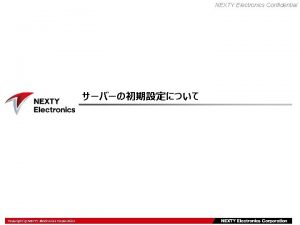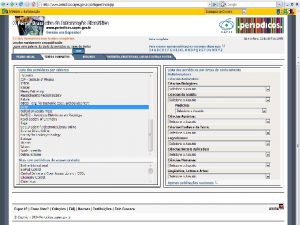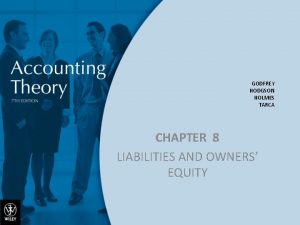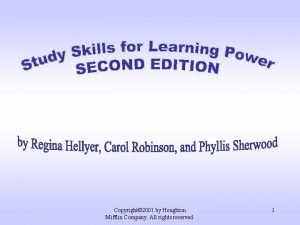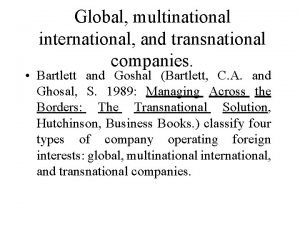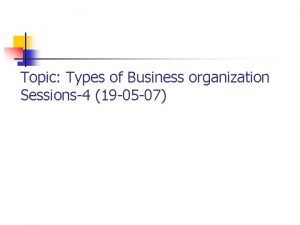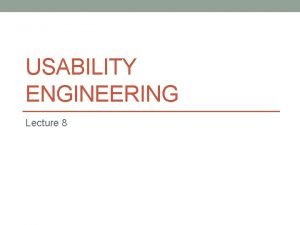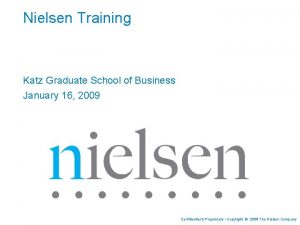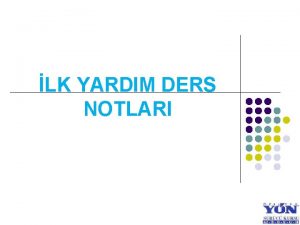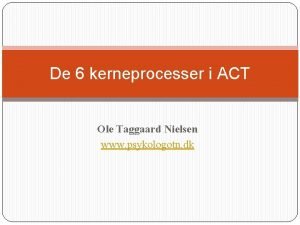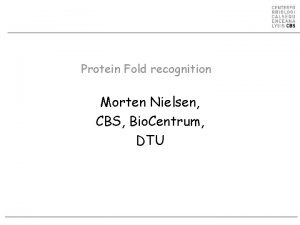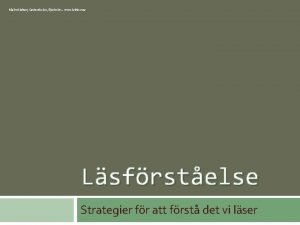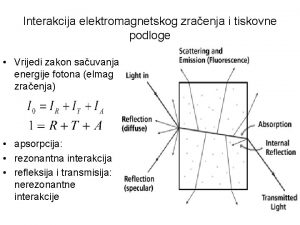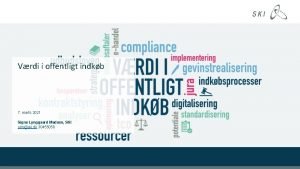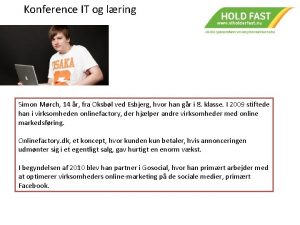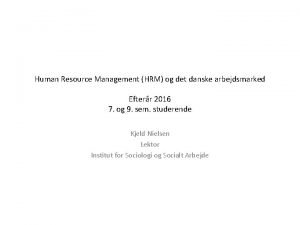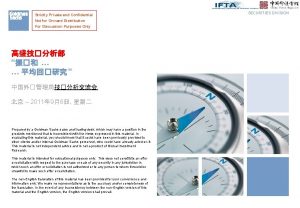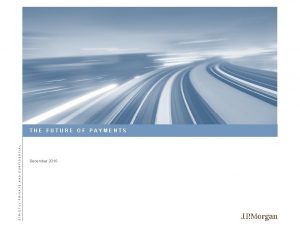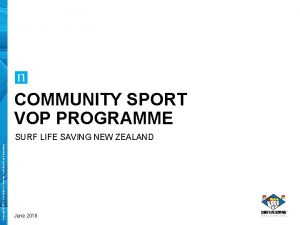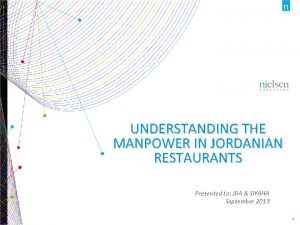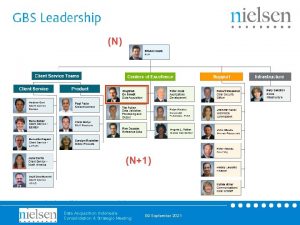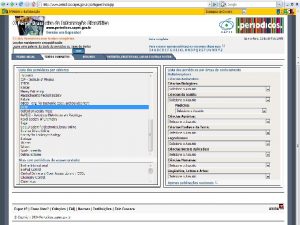Copyright 2017 The Nielsen Company Confidential and proprietary







































































- Slides: 71

Copyright © 2017 The Nielsen Company. Confidential and proprietary. COMMUNITY SPORT VOP PROGRAMME NEW ZEALAND FOOTBALL September 2017

Copyright © 2017 The Nielsen Company. Confidential and proprietary. CONTENTS INTRODUCTION 3 EXECUTIVE SUMMARY 4 KEY METRIC RESULTS 6 MAIN FINDINGS 7 WHAT IS CAUSING THESE RATINGS 18 LENGTH OF MEMBERSHIP & THE JOINING PROCESS 30 INJURY MANAGEMENT 34 DEMOGRAPHIC DIFFERENCES 40 FOOTBALL FEDERATION DIFFERENCES 46 QCM TIER RATINGS 54 SAMPLE PROFILE 58 BACKGROUND, OBJECTIVES AND APPROACH 66 2

INTRODUCTION This report looks at the results for New Zealand Football to understand the club experience of their members in 2017. For more information about the background and objectives of the VOP Programme and this research please refer to the ‘Background, Objectives and Approach’ section. More than 82, 000 affiliated football club members had the opportunity to participate, with adults aged 16+ completing the questionnaire themselves (‘players’) and parents/guardians (‘parents’) completing the questionnaire for children under the age of 16, on behalf of their child. When level of satisfaction is referenced in the report (i. e. the percentage who are ‘more than satisfied’), the top two results (‘very satisfied’ or ‘extremely satisfied’) of a positively skewed satisfaction scale are used (shown below). ‘MORE THAN SATISFIED’ Copyright © 2017 The Nielsen Company. Confidential and proprietary. EXTREMELY DISSATISFIED VERY SATISFIED EXTREMELY SATISFIED Positively skewed scales are used because the neutral ratings are divided between dissatisfaction and satisfaction (as opposed to a neutral mid point in a balanced scale). This gives the opportunity for some of the ‘very satisfied’ to be ‘delighted’, allowing for more variation/ greater discrimination compared with a balanced scale. In addition, a neutral option offers people an option not to think. If this is really true, then they have the ‘don’t know/ can't say’ option to select. Finally, in a competitive world today, is good…good enough? Good (or just satisfied) does not necessarily build strong relationships. We want members to rate their experience more than just satisfied, so they are real advocates and positively endorse their club and sport. 3

EXECUTIVE SUMMARY KEY METRICS When compared to the club experience across all sports in 2016/17, the football experience is rated lower. Three in five (61%) football respondents are more than satisfied with the overall experience of playing at their club, a consistent score compared with the average for all sports in 2016/17 (61%) and the total football result in 2016 (60%). However, despite being a significant increase from the 2016 results, the likelihood of respondents to recommend their club (NPS score +35), is significantly lower compared with the average for all sports. The NPS score measures the proportion of respondents who are likely to recommend (rated 9 or 10, with 10 being extremely likely to recommend) minus those not likely to recommend (0 to 6, with 0 being not at all likely to recommend). Another important measure for experience, that is rated significantly lower football (consistent with 2016) is value for money. Two thirds (67%) perceive value for money, that is, the opportunities, services, and benefits that they receive from their club make it worth the money that they pay. Copyright © 2017 The Nielsen Company. Confidential and proprietary. DRIVERS OF THE CLUB EXPERIENCE The top three drivers of recommendation for football respondents are value for money, being professional and well managed and allowing me to fulfil my potential. Being fair and responsive should be the priority for improvement, with low performance and high importance, placing it in the priority for improvement quadrant. In some of the key drivers, levels of satisfaction are significantly lower when compared with the average for all sports 2016/17 i. e. the social environment, having well maintained playing/training venues/fields and well maintained facilities. The relative strength of clubs are being friendly and welcoming and the quality of the coaches. FOCUS FOR IMPROVEMENT Respondents who were dissatisfied (or extremely dissatisfied) with any of the key factors were asked to select the one aspect they are least satisfied with. One in seven (14%) indicated they are least satisfied with having qualified/experienced officials, followed by having well maintained playing/training venues/fields (12%). As a follow up, respondents were asked where they would like their club to focus investment if fees were to increase. Overall, one in five (21%) indicate player development programmes, although a quarter of parents of players (27%) indicate this is the area for improvement compared with only 14% of players. 4

EXECUTIVE SUMMARY CLUB MEMBERSHIP CHARACTERISTICS Less than one percent of respondents identified as casual players. Of those who are affiliated members of a football club, the main reason they belong is to have fun (31%) followed by to play competitively (26%) and to learn/improve skills (23%). Overall, satisfaction and perceived value for money both decrease based on length of membership and are significantly higher for those who have been members for less than 1 year (64% satisfaction, 71% value for money). Conversely, NPS and likelihood to rejoin are significantly higher for those who have been members for more than ten years (52 NPS, 88% likelihood to rejoin). Copyright © 2017 The Nielsen Company. Confidential and proprietary. Football respondents who were injured in the last 12 months are more satisfied with the injury management process, with the proportion more than satisfied with each attribute ranging from 61% to 69%. Compared to 2016, the football results for 2017 are significantly higher for all injury attributes. FIT 4 FOOTBALL Using just the name, a quarter of respondents (23%) have heard of Fit 4 Football. When described in a little bit more details, this figure increases to a third (32%). FEDERATION DIFFERENCES Respondents from Wai. BOP (64%), Central (64%) and Football South (69%) federations are significantly more likely to be more than satisfied with the overall experience at their club (cf. 61% total). There is a significantly lower proportion of members from Northern (57%) and Mainland (58%) football that are more than satisfied with the overall experience. 5

KEY METRIC RESULTS HOW ARE FOOTBALL CLUBS PERFORMING? � 61 60 61 67 68 � 35 SATISFACTION Copyright © 2017 The Nielsen Company. Confidential and proprietary. (Q 6: % more than satisfied) Three in five (61%) of respondents are more than satisfied with the overall experience of playing football at their club. This is on par with last years results and the average for all sports in 2016/17. TOTAL FOOTBALL 2017 TOTAL FOOTBALL 2016 ALL SPORTS 2016/17 74 80 77 82 52 51 53 40 27 NPS (Q 7: % promoters less % detractors) Respondents are likely to recommend their current club to someone interested in playing football, illustrated by a Net Promoter Score (NPS) of +35. This is significantly higher than 2016, but still significantly lower than the average for all sports in 2016/17. VALUE FOR MONEY LIKELIHOOD TO REJOINING PROCESS (Q 11: % agree or strongly agree) (Q 9: % quite likely or very likely) Two thirds (67%) of respondents perceive value for money from their football club. That is; the opportunities, services and benefits they receive from their rugby club make it well worth the money they pay. This is a significantly lower proportion than the average for all sports in 2016/17. Four in five (80%) indicate they are likely to rejoin their current club next season, which has increased from 2016, however, it is still significantly lower than the average for all sports in 2016/17. (Q 20: % more than satisfied – average of 4 attributes) Base: Q 6/Q 7/Q 11 All Respondents (Excluding Don't know/ Can't say), Q 9 Members Excluding Don’t know/Can’t say), Q 20 New Members (Excluding Don't know/ Can't say) Q 6 (n=8758) / Q 7 (n=8686) / Q 11 (n=8604) / Q 9 (n=8493) / Q 20 (n=2377 -2514) (Average of four attributes) For new members (less than a year), half (52%) are more than satisfied with the process they went through when they joined their club. This is on par with the average for all sports in 2016/17, and the 2016 result. � �Significantly higher/lower than Total Football 2016 / Significantly higher/lower than All Sports 2016/17 6

MAIN FINDINGS Copyright © 2017 The Nielsen Company. Confidential and proprietary.

MEMBER TYPE ALMOST ALL RESPONDENTS ARE MEMBERS Almost all respondents are members of a football club with only a small proportion (<1%) indicating they play casually. 98% Copyright © 2017 The Nielsen Company. Confidential and proprietary. 92% are affiliated members of a football club 2% Member and currently playing season has just finished 2% 2% <1% 1% Member but not playing due to injury Member but not playing for another reason Casual player Other Base: All respondents (n=8937) Q 2. Which of the following best describes your/ your child's current relationship with football ? 8

REASON FOR BELONGING TO A CLUB A THIRD BELONG TO ‘HAVE FUN’ 31% 33% � 29% � To have fun 26% 22% � To play competitively 31% � 23% 32% � To learn/ improve skills Just under one third (31%) indicate the main reason for belonging to a football club is to have fun (parents (33%) significantly more so than players (29%), followed by a quarter (26%) who belong to play competitively (although this is the main reason for players) and learn/improve skills (23%). To learn/improve skills is close behind have fun for parents (32% and 33% respectively). OTHER REASONS TO BELONG TO A CLUB INCLUDE: 13% � To get fit and healthy Copyright © 2017 The Nielsen Company. Confidential and proprietary. To socialise 6% 3% � 10% � To have access to facilities and playing fields/ venues/ courts 1% 1% 1% Other 4% 3% 4% TOTAL FOOTBALL (n=8769) “To play organised football ("competitively" sounds too intense). ” Parent of player, 11 -12 years, Auckland 9% 5% � 13% � PARENT (n=4769) “The reasons have changed over the years, it started with competitive football and now I play because I enjoy playing. . . although I'm getting old!” Player, 35 -39 years, Wellington “School does not have a team, therefore, club is only option however happy about this. ” Parent of player, 8 -10 years, Whanganui “To develop greater technical understanding and technical ability. As well have a higher level of coaching. ” Parent of player, 15 years, Auckland “To develop a career out of football. ” Player, 15 years, Wellington PLAYER (n=4000) Base: All respondents who are members Q 4. What is the main reason you/ your child belong/ belongs to a football club? “To play in the same team as my futsal mates, had never been a fan of the club itself. ” Player, 30 -34 years, Bay of Plenty “He simply loves football, though socialising, getting discipline and team spirit and health are also our concern. ” Parent of player, 8 -10 years, Wellington �� Significantly higher/lower than Total Football 2017 9

MEMBER OF ANOTHER CLUB TWO IN FIVE HAVE BEEN MEMBERS OF ANOTHER CLUB Of the respondents who have been members of another club, a third (35%) indicated that the main reason they changed club was due to location i. e. they moved. Around one in ten changed club for better opportunities to fulfil their potential (10%) or because they know/knew someone at the club (9%). Only 1% changed clubs due to fees. MEMBER OF ANOTHER CLUB Location e. g. I/ we moved/ the club moved 35% Better opportunities to fulfil my/ their potential 10% I know or knew someone at the club 9% To change grades/ levels/ play in a different team 8% Better quality of coaches or instructors 6% The club was more friendly and welcoming 41% Copyright © 2017 The Nielsen Company. Confidential and proprietary. 59% No Better club management 5% 3% Better playing/ training venues/ fields 2% Better social environment at the club 2% Lower fees 1% Better access to playing/ training venues/ fields 1% Yes Other Don't know or can't remember 16% 1% ‘Other’ includes: ► Moved from school to club ► Clubs merged ► Play with people of similar ability ► No team in my age/grade/division ► Play with friends Football members significantly more likely to have changed clubs are: Football members significantly less likely to have changed clubs are: ► Those who primarily belong to a club to play competitively (56% cf. 41%), to socialise ► Those who primarily belong to a club to learn/improve skills (27% cf. 41%) or have fun ► ► (55%) or to get fit and healthy (47%) Those who reside in Nelson (55%) or Auckland (43%) Those who play/train four or more times a week (54%) Those who have represented the top team at their club or higher honours (53%) Those who have made a complaint in the last 3 months (50%). Base: All respondents who are members (n=8937) Q 31. Have/ Has you/ your child ever been a member of another football club? Base: All respondents who are members and used to belong to another club (n=3584) Q 32. What is the main reason you/ your child changed football clubs? ► ► (33%) Those who identify as Asian (29%) or Maori (33%) Those who play /train once a week (35%) or two or three times a week (39%) Females (39%) Those who reside in Gisborne (28%), Tasman (29%), Otago (36%) or Canterbury (38%). �� Significantly higher/lower than Total Football 2017 � �Significantly higher/lower than Total Football 2016 10 / Significantly higher/lower than All Sports 2016/17

RETENTION FOUR IN FIVE MEMBERS ARE LIKELY TO REJOIN THEIR CURRENT CLUB NEXT SEASON Although four in five (80%) members are more than likely to rejoin their current club next season, which is significantly higher than 2016, it is still significantly lower than the average for all sports in 2016/17 (82%). Compared with 2016, there is a lower proportion that have indicated they are unlikely to rejoin next season (11% cf. 13%). LIKELIHOOD TO REJOIN Copyright © 2017 The Nielsen Company. Confidential and proprietary. 62% Somewhat Likely Very Likely Unlikely Likely Very Unlikely 80% 77% 11%� 11% 13% TOTAL FOOTBALL 2017 (n=8493) PARENT (n=4630) PLAYER (n=3863) Football members significantly less likely to rejoin are: ► ► ► ► ► Those who have been a member more than 10 years (88% cf. 80%) Older adults (35+ years) (86%) or those of primary/intermediate age (5 -12 years) (82%) Those who reside in Northland (85%) Those of Asian/Indian ethnicity (84%) Those who play/train two or three times a week (81%). 11% ALL SPORTS TOTAL 2016/17 FOOTBALL (n=24171) 2016 (n=7781) Football members significantly more likely to rejoin are: Base: All respondents who are members (Excluding Don't know/not applicable) Q 9. How likely are/ is you/ your child to play for or rejoin <insert club from Q 2 a> next season? 82% MORE THAN LIKELY TO REJOIN 18% UNLIKELY OR VERY UNLIKELY TO REJOIN 6% 4% 9% 80%� Those who play/train less than once a week (55% cf. 80%) Those aged 20 -34 (74%) or of secondary age (13 -19) (75%) Those who have been a member 6 -10 years (76%) Those who primarily belong to a club to play competitively (78%) Females (78%). �� Significantly higher/lower than Total Football 2017 � �Significantly higher/lower than Total Football 2016 11 / Significantly higher/lower than All Sports 2016/17

CLUB SATISFACTION THREE IN FIVE RESPONDENTS ARE MORE THAN SATISFIED 7%2% 26% Copyright © 2017 The Nielsen Company. Confidential and proprietary. 30% 34% Satisfied Extremely satisfied Dissatisfied Very satisfied MORE THAN SATISFIED SATISFACTION WITH CLUB EXPERIENCE 61% 60% 61% DISSATISFIED Three in five (61%) are more than satisfied with the overall experience of playing at their club (very satisfied or extremely satisfied). This is comparative to the average for all sports in 2016/17 (61%), although there is a significantly lower proportion that indicated they are dissatisfied. Parents of players are significantly more likely to indicate they are dissatisfied with the overall experience with their club (10% cf. 8% players). 9%� 10%� 8%� 11% 10% PARENT (n=4758) PLAYER (n=4000) TOTAL FOOTBALL 2016 (n=7984) ALL SPORTS 2016/17 (n=24784) TOTAL FOOTBALL 2017 (n=8758) Extremely dissatisfied Football respondents significantly more likely to be satisfied are: Football respondents significantly less likely to be satisfied are: ► ► ► ► ► Those who reside in Northland (68% cf. 61%), Otago (68%) or Bay of Plenty (66%) Those who play/train four times a week or more (64%) Those who primarily belong to a club to have fun (63%) Females (63%) Those of primary/intermediate age (5 -12) (63%) Those who have played for top team at their club or higher honours (63%). Those aged 20 -34 years (54% cf. 61%) Those who play/train once a week or less (56%) Those who reside in Auckland (57%) Those who primarily belong to a club to get fit and healthy (57%) or to play competitively (59%) ► Males (60%). Base: All respondents (Excluding Don't know/not applicable) Q 6. To what extent are you satisfied or dissatisfied with the/ your child’s overall experience of playing football at your/ their club? �� Significantly higher/lower than Total Football 2017 � �Significantly higher/lower than Total Football 2016 12 / Significantly higher/lower than All Sports 2016/17

CLUB RECOMMENDATION MORE THAN HALF OF RESPONDENTS ARE LIKELY TO RECOMMEND THEIR CLUB TO SOMEONE INTERESTED IN PLAYING FOOTBALL More than half (53%) of respondents are likely to recommend their football club to someone interested in playing football (rated 9 or 10, with 10 being extremely likely). This resulting NPS score is significantly lower than the average across all sports in 2016/17 (+35 cf. +40), however, it is significantly higher than the result in 2016. The proportion of respondents that are promoters is significantly higher, while detractors is significantly lower in 2017. +35 � NPS: +35 53% 53% 18% 20%� 17%� PROMOTERS 29% PASSIVES PROMOTERS DETRACTORS 53% Copyright © 2017 The Nielsen Company. Confidential and proprietary. +36� +27 +40 � 18% DETRACTORS +34� � TOTAL FOOTBALL 2017 (n=8686) NPS = % PROMOTERS - % DETRACTORS PARENT (n=4740) PLAYER (n=3946) 58% 49% 22% 18% TOTAL FOOTBALL 2016 (n=7965) ALL SPORTS 2016/17 (n=24801) Football respondents significantly more likely to recommend their club are: Football respondents significantly less likely to recommend their club are: ► Those who primarily belong to a club to learn/improve skills (56% cf. 53%) or to have ► ► ► ► ► fun (55%) Females (56%) Members for more than 10 years (63%) Those aged 55 -64 years (63%) or those of primary/intermediate age (5 -12) (55%) Those who reside in Northland (61%), Hawkes Bay (60%), Whanganui (70%), Otago (60%), or Southland (71%). Those who have made a complaint to their club (23% cf. 53%) Those who play/train less than once a week (41%) Those aged 16 -24 years (46%) Those who primarily belong to a club to play competitively (48%) Those who reside in Auckland (51%), Wellington-Wairarapa (51%), or Canterbury (47%). Base: All respondents (Excluding Don't know/not applicable) Q 7. Imagine someone is interested in playing or participating in football. If they asked you, how likely are you to recommend your/ your child's club to them, using a scale of 0 to 10 where 0 is not at all likely and 10 is extremely likely? �� Significantly higher/lower than Total Football 2017 � �Significantly higher/lower than Total Football 2016 13 / Significantly higher/lower than All Sports 2016/17

WHAT THEY LOVE ABOUT THEIR CLUB “Facilities /uniforms and balls are made available to the team. Our coach is keen to see improvements in the kids participating. Games are run professionally and the team understands what it is to lose and win and still have fun. Competitiveness is important also. ” Parent of player, 11 -12 years, Waikato Copyright © 2017 The Nielsen Company. Confidential and proprietary. “The club are super organised with the children's football program. They offer fun activities for the Saturday morning program. The club members involved with the program are very friendly, welcoming and helpful. This is our first season of football, and we have been very impressed with the club. ” Parent of player, 5 -7 years, Taranaki “The socialising/support of the members/players, great coaching staff and players to play with, great environment to be in. ” Player, 16 -19 years, Whanganui “Social club that is great to be part of. A great bunch of lads. Only the chosen few, wear the gold and blue!” Player, 35 -39 years, Auckland Base: All respondents who gave an NPS score of 9 or 10 (n=4610) Q 8 a. What is it that you love about your/ your child's club? “Great support, knowledgeable volunteers, good facilities, plenty of social opportunities with other kids, good morals (i. e. chill out on the side lines parents!) relaxed not too serious”. Parent of player, 5 -7 years, Bay of Plenty “Great players, great coaches, and awesome facilities. Very involving club, gives opportunities to players at all levels and age groups. Senior teams give back to junior teams by coaching etc. ” Player, 16 -19 years, Canterbury “Everyone is friendly and the communication from the club has been great. Kids love meeting kids from other schools and have a great time playing. No pressure to be competitive at their age either. ” Parent of player, 5 -7 years, Wellington “I love the atmosphere and attitude of the team, extremely driven and competitive but simultaneously having fun and enjoying just playing football, I love the sense of community and family. ” Player, 16 -19 years, Otago 14

WHAT NEEDS TO IMPROVE Copyright © 2017 The Nielsen Company. Confidential and proprietary. “Better training opportunities for youth players at lower cost than currently offered. Less of a who knows who management system. Better selection / trial process with more selectors. Promotion of the club to attract more rep players. Introduce younger skilled coaches. ” Parent of player, 11 -12 years, Auckland “I dislike the way the Premier Team is given preference at all times even when it means it effects the kids morale. We were told we had to give up 1 player for the premier team. This has left our kids team short of players. We are asked to provide subs to the prem team, even if it would make our team short. We are constantly reminded our kids come second. These kids had trials the club made their choice for prem team, then they start hand picking kids half way through the season. We cannot just provide any keen kids to sub for prem team, these subs are hand picked too! I don't think kids best interests are at heart. Seriously thinking of finding another club. Know other parents are too. ” Parent of player, 11 -12 years, Wellington “More support for lower teams. We often feel neglected, and it seems like all support goes to the top team(s) only. ” Player, 25 -29 years, Auckland Base: All respondents who gave an NPS score of 0 to 6 (n=1600) Q 8 c. What would need to improve at your/ your child's club to improve your rating? “Most people I know are parents who are looking to get their young children involved. My club has a great program but a lot of parents feel the club is under resourced - 1 -2 volunteers are trying to coordinate what is a very large program, resulting in perceived lack of communication about potential opportunities for kids. ” Parent of player, 11 -12 years, Auckland “The club has become a joke. They haven't good coaches and the coaches don't even go to the games. The clubhouse is a dump and the selection for development teams is a laugh. They are just clueless. ” Parent of player, 8 -10 years, Auckland “Better main pitch. Maybe a sand based pitch would be a best option. I would say turf but seems highly unlikely for a football club with little exposure to get a turf pitch. Also need more quality players coming through. Such as youth. Maybe setup a youth development programme where we can get fresh talent. Going back to exposure of the club, I think this is one of the main reasons why we are not getting quality players. And we as a club need to put our selves on the football map. ” Player, 35 -39 years, Canterbury 15

VALUE FOR MONEY TWO THIRDS PERCEIVE VALUE FOR MONEY Two thirds (67%) of respondents more than agree that the opportunities, services and benefits they receive from their football club make it well worth the money they pay. This is on par with last year (2016), but a significantly lower result when compared with the average for all sports in 2016/17. Players, compared with parents, are significantly less likely to perceive value for money. 4% 33% Copyright © 2017 The Nielsen Company. Confidential and proprietary. 21% 34% Somewhat agree Strongly agree Disagree Agree Strongly disagree DISAGREE 8% 74% 67% 70%� 12% 11%� 14%� 13% 10% PARENT (n=4716) PLAYER (n=3888) TOTAL FOOTBALL 2016 (n=7888) ALL SPORTS 2016/17 (n=24466) 64%� 68% AGREE OR STRONGLY AGREE PERCEIVED VALUE FOR MONEY TOTAL FOOTBALL 2017 (n=8604) Football respondents significantly more likely to perceive value for money are: Football respondents significantly less likely to perceive value for money are: ► ► ► ► Those who have been members for more than 5 years (62% cf. 67%) ► Those who primarily belong to a club to play competitively (64%) or get fit and healthy Those very likely to rejoin their club next season (81% cf. 67%) Those who have been members for less than 2 years (71%) Those who primarily belong to a club to learn/improve skills (72%) Those who play/train four times a week or more (71%) Those of primary/intermediate age (5 -12) (72%) Those who reside in Bay of Plenty (74%), Taranaki (75%), Whanganui (78%), Otago (74%) or Southland (81%) ► Those who have played for top team at their club or higher honours (70%). (62%) ► Those who play/train less than once a week (53%) ► Those aged 20 -34 years (55%) or 35+ (60%) ► Those who reside in Auckland (64%) or Canterbury (61%). Base: All respondents (Excluding Don't know/not applicable) Q 11. To what extent do you agree or disagree with the following. . . The opportunities, services and benefits they receive from their rugby club make it well worth the money they pay �� Significantly higher/lower than Total Football 2017 � �Significantly higher/lower than Total Football 2016 / Significantly higher/lower than All Sports 2016/17 16

IN THE LAST THREE MONTHS… FEWER THAN ONE IN TEN MADE A COMPLAINT Fewer than one in ten (7%) have made a complaint to their club in the last 3 months which is consistent across both players and parents. This is also on par with the result from 2016 and significantly lower when compared to the average for all sports in 2016/17. MADE A COMPLAINT IN THE LAST THREE MONTHS 9% 7% 7% 7% TOTAL FOOTBALL 2017 (n=8805) PARENT (n=4775) PLAYER (n=4030) TOTAL FOOTBALL 2016 (n=8013) 7% 93% Copyright © 2017 The Nielsen Company. Confidential and proprietary. 7% No Yes ALL SPORTS 2016/17 (n=24848) Football respondents significantly more likely to have made a complaint are: Football respondents significantly less likely to have made a complaint are: ► ► ► ► Members for less than 2 years ( 5% cf. 7%) ► Those who primarily belong to a club to have fun (5%) ► Those who play/train once a week or less (6%). Those who have been members for 6 -10 years (10% cf. 7%) Those who primarily belong to a club to play competitively (9%) Those who play/train four times a week or more (9%) Those who are unlikely to rejoin their club next season (16%) Those who reside in Auckland (8%) Those who have played for top team at their club or higher honours (9%). Base: All respondents (Excluding Don't know/not applicable) Q 19. Have you complained to your/ your child's club in the past 3 months? �� Significantly higher/lower than Total Football 2017 � �Significantly higher/lower than Total Football 2016 17 / Significantly higher/lower than All Sports 2016/17

WHAT IS CAUSING THESE RATINGS? Copyright © 2017 The Nielsen Company. Confidential and proprietary.

DRIVERS OF THE CLUB EXPERIENCE The qualitative stage, undertaken as part of the development of the VOP questionnaire, identified seven drivers that influence club experience. After the initial pilot of the VOP questionnaire these were expanded to nine core drivers. The question numbers that relate to each driver are shown below. BEING FRIENDLY & WELCOMING Q 10 a(R 1) SOCIAL ENVIRONMENT CLEAN & WELL MAINTAINED FACILITIES Q 10 a(R 9) Q 10 a(R 2) PROFESSIONAL & WELL MANAGED Q 10 a(R 8) Copyright © 2017 The Nielsen Company. Confidential and proprietary. HAVING WELL MAINTAINED PLAYING/ TRAINING VENUES POSITIVE MEMBER EXPERIENCE FAIR & EQUAL OPPORTUNITIES Q 10 a(R 3) QUALITY OF COACHES Q 10 a(R 4) Q 10 a(R 7) FULFILLING POTENTIAL Q 10 a(R 6) PROVIDING INFORMATION WHEN NEEDED Q 10 a(R 5) 19

DRIVERS OF THE CLUB EXPERIENCE CONTINUED As well as the nine ‘core’ drivers of the club experience, based on the pilot results and in consultation with National Sporting Organisations (NSOs) the VOP survey also covers a number of secondary drivers. These are shown below with the associated question number. ► Value for money (Q 11) ► Encourages good sportsmanship and fair play (Q 10 b-R 1) ► The ease of accessing the clubs venues/ fields/ courts for training or casual playing (Q 10 b-R 2) ► Fostering a sense of pride in the club (Q 10 b-R 3) ► Engaging with the local community (Q 10 b-R 4) ► Being responsive to needs and requirements (Q 10 b-R 5) ► Having qualified/ experienced officials available when I compete (Q 10 b-R 6) ► Providing a safe environment for adults and children (Q 10 b-R 7) ► Making aware of development occurring in football across New Zealand in terms of training, equipment, new programmes, Copyright © 2017 The Nielsen Company. Confidential and proprietary. coaching and officiating, Fit 4 Football, club and event management (Q 10 b-R 8) ► Providing information and opportunities for coach development (Q 10 b-R 9) ► Providing information and opportunities for officials development (Q 10 b-R 10) ► Providing information about junior programmes (Q 10 b-R 11). In addition, individual NSOs had the opportunity to add other drivers considered important or topical for their sport, if required. For football these were: ► Encouraging good player welfare principles e. g. nutrition & hydration, warm-ups/ cool downs (Q 10 b-R 18) ► Providing player development programmes (Q 10 b-R 19). 20

EXPLANATION OF REGRESSION Regression analysis is a statistical process for analysing the relationship between two or more variables. It helps to understand the importance, or impact, of a ‘driver’ (the independent variable) by measuring its contribution to explaining variance in another variable (the dependent variable). Each independent variable is assigned a score ranging from zero to one - the closer to one, the more important/ impact it has on the dependent variable. We have used a regression approach called Modified Kruskal, which addresses any multi-collinearity issues. Nielsen has created a regression model unique to Football New Zealand (note: previously Nielsen created one overall model that used the data from all sports). Copyright © 2017 The Nielsen Company. Confidential and proprietary. The dependent variable for the regression model is recommendation (the likelihood of a respondent to recommend their club to someone interested in playing football). The independent variables are the attributes/ drivers in Q 10 a, Q 10 b and Q 11, including any optional or additional attributes. The following chart shows the impact of each attribute/ driver on a respondents’ likelihood to recommend their club. The importance or impact of a driver on recommendation is shown on the vertical axis along with the size of the bubble (from the regression model). How respondents are rating their satisfaction with each of the drivers, is shown on the horizontal axis. This allows us to see what is more important but rated lower - that is where clubs should focus, in order to improve recommendation. 21

DRIVERS OF RECOMMENDATION (NPS) The top three drivers of recommendation for football respondents are: PRIORITY FOR IMPOVEMENT STRENGTHS High 1. Value for money 1 2. Being professional and well managed Copyright © 2017 The Nielsen Company. Confidential and proprietary. There a number of relative strengths, although overall performance is relatively low. Emphasis should be placed on improving responsiveness to needs and requirements which has relatively low performance and is in the priority for improvement quadrant. 3 IMPORTANCE OF DRIVER ON NPS 3. Allowing me to fulfil my potential. 2 4 10 7 9 8 20 22 23 21 11 18/19 16 17 12 13 14 15 Low SECONDARY PRIORITY 35% STRENGTHS 3. 4. 5. 6. 7. 8. 9. Mean = 56% MAINTENANCE 75% PERFORMANCE (% MORE THAN SATISFIED) 1. Value for money 2. Being professional and well Base: All Respondents (Excluding Don't know/not applicable) Q 7. Imagine someone is interested in playing or participating in football. If they asked you, how likely are you to recommend your/ your child's club to them, using a scale of 0 to 10 where 0 is not at all likely and 10 is extremely likely? 5 6 PRIORITY FOR IMPROVEMENT SECONDARY PRIORITY 10. Being responsive to my needs and 15. Having clean and well maintained 20. Providing player development requirements managed MAINTENANCE Allowing me to fulfil my potential 11. Encouraging good sportsmanship Is fair and provides equal and fair play opportunities for all players 12. Providing a safe environment for Being friendly and welcoming adults and children The quality of the coaches 13. The ease of accessing the clubs Fostering a sense of pride venues/ fields Providing the information when 14. Having well maintained needed playing/training venues/ fields The social environment at the club facilities e. g. clubrooms, changing programmes rooms, toilets 21. Providing information and 16. Providing information about junior opportunities for officials programmes development 17. Encouraging good player welfare 22. Making aware of the principles e. g. nutrition & developments occurring in football hydration, warm-ups/ cool downs across New Zealand in terms of 18. Engaging with the local training, equipment, new community programmes, coaching and 19. Providing information and officiating, club and event opportunities for coach management development 23. Having qualified / experienced officials 22

SATISFACTION: KEY DRIVERS The level of satisfaction with the key drivers is relatively consistent with 2016, with the proportion that indicated they are more than satisfied ranging from 51% to 74%. Respondents are less satisfied with having well maintained playing/training venues/ fields than they were in 2016. BEING FRIENDLY AND WELCOMING (n=8725) 3% 1% THE QUALITY OF THE COACHES OR INSTRUCTORS (n=8317) 2% 8% PROVIDING ME/ THEM THE INFORMATION I/ THEY NEED WHEN I/ THEY NEED IT (n=8632) 6% 1% Copyright © 2017 The Nielsen Company. Confidential and proprietary. IS FAIR AND PROVIDES EQUAL OPPORTUNITIES FOR ALL PLAYERS (n=8577) 9% 3% BEING PROFESSIONAL AND WELL MANAGED (n=8639) 2% 8% THE SOCIAL ENVIRONMENT AT THE CLUB (n=8031) 6% 1% % MORE THAN SATISFIED TOTAL PLAYER PARENT TOTAL ALL SPORTS FOOTBALL 2016/17 FOOTBALL 2016 2017 22% 33% 27% 41% 30% 31% 27% 29% 32% 33% 74% 77%� 71% 72% 62% 63% 59% 62% 59% 61% 34% 29% 62% 63% 31% 30% 61% 60% � 63%� 33% 28% 61% 60% 62% 59% 61% 33% 28% 61% 68%� 54% � 57% 63% 59% 57% ALLOWING ME/ THEM TO FULFIL MY/ THEIR POTENTIAL (n=8465) 10% 2% 30% 32% 26% 58% 54% 59% HAVING WELL MAINTAINED PLAYING/ TRAINING VENUES/ FIELDS (n=8661) 2% 10% 31% 27% 57%� 53% � 61% � 59% 65% 54% � 48%� 58% HAVING CLEAN AND WELL MAINTAINED FACILITIES E. G. CLUBROOMS, CHANGING ROOMS, TOILETS (n=7604) Extremely dissatisfied 3% 10% Dissatisfied 36% Satisfied 29% Very Satisfied 22% 51% 48% Extremely Satisfied Base: All respondents (Excluding Don't know/not applicable) Q 10 a. How would you/ your child rate your/ their overall satisfaction with your/ their football club on each of the following… �� Significantly higher/lower than Total Football 2017 � �Significantly higher/lower than Total Football 2016 23 / Significantly higher/lower than All Sports 2016/17

SATISFACTION: SECONDARY DRIVERS Performance across the secondary factors ranges from 35% to 70% more than satisfied. Compared with the average for all sports in 2016/17, there is a significantly higher proportion that are more than satisfied with providing a safe environment, encouraging good sportsmanship and fair play, providing information about junior programmes and providing information and opportunities for coach development. Conversely, they are significantly less likely to be more than satisfied with ease of accessing venues/fields, engaging the local community and having qualified/ experienced officials available. % MORE THAN SATISFIED TOTAL PLAYER FOOTBALL 2017 PROVIDING A SAFE ENVIRONMENT FOR ADULTS AND CHILDREN (n=8600) ENCOURAGING GOOD SPORTSMANSHIP AND FAIR PLAY (n=8613) FOSTERING A SENSE OF PRIDE IN OUR/ THEIR CLUB (n=8304) 3% 1% 36% 28% 7% 1% 35% TOTAL ALL SPORTS FOOTBALL 2016/17 2016 34% 70% 72% � 69%� 70% 68% 34% 69% 68% 67% 32% 31% 28% 60% 63%� 57% � 58% 61% 33% 32% 27% 59% 60% 58% 63% THE EASE OF ACCESSING THE CLUBS VENUES/ FIELDS(n=8147) 6% 1% BEING RESPONSIVE TO MY/ THEIR NEEDS AND REQUIREMENTS (n=8211) 8% 2% PROVIDING INFORMATION ABOUT JUNIOR PROGRAMMES (n=7061) 2% 9% 38% 1% 7% 43% ENGAGING WITH THE LOCAL COMMUNITY (n=6973) Copyright © 2017 The Nielsen Company. Confidential and proprietary. 1% 28% PARENT 38% 31% 21% 52% 53% 52% 49% 52% 29% 21% 51% 51% - 49% 29% 19% 48% 51% � 46% � 48% 51% PROVIDING INFORMATON AND OPPORTUNITIES FOR COACH DEVELOPMENT (n=5835) 11% 2% 39% 29% 19% 48% 47% 49% - 44% ENCOURAGING GOOD PLAYER WELFARE PRINCIPLES* (n=7758) 2% 10% 40% 28% 20% 48% 49% 48% - - PROVIDING INFORMATON AND OPPORTUNITIES FOR OFFICIALS DEVELOPMENT (n=5519) 2% 10% 45% 43% � 46% � - 44% 45% 43% � 46% � - - 15% 38%� 36% � 39% 39% 14% 35% 32% � 38% � 45% 43% PROVIDING PLAYER DEVELOPMENT PROGRAMMES* (n=6872) 3% 16% MAKING ME AWARE OF THE DEVELOPMENTS OCCURRING IN FOOTBALL (n=6848) 3% 17% HAVING QUALIFIED / EXPERIENCED OFFICIALS AVAILABLE WHEN I/ THEY COMPETE (n=6801) Extremely dissatisfied 5% Dissatisfied 28% 37% 25% 42% 19% 40% Satisfied 17% Very Satisfied Base: All respondents (Excluding Don't know/not applicable) Q 10 b. How would you rate your/ your child's overall satisfaction with your/ their football club on each of the following. . . * Not asked of all sports 19% 23% 21% 34% Extremely Satisfied �� Significantly higher/lower than Total Football 2017 � �Significantly higher/lower than Total Football 2016 24 / Significantly higher/lower than All Sports 2016/17

HOW CAN CLUBS IMPROVE EXPERIENCE Respondents who were dissatisfied (or extremely dissatisfied) were asked to select the one aspect they are least satisfied with. While there is no one aspect a large proportion of respondents selected, one in seven indicated they are least satisfied with having qualified/ experienced officials available (14%) and having well maintained playing/ training venues/ fields (12%). Players are significantly more likely to indicate these two aspects, while parents of players place a greater emphasis on the quality of coaches and ensuring the club provides fair and equal opportunities (11% respectively). Having qualified / experienced officials Having well maintained playing/ training venues/ fields 7%▼ WHAT WOULD THEY NEED TO BE MORE SATISFIED? “Have referees available at games. Often there are some teams whose referees are not actual officials, but blokes watching who ref!” 9% 9% 9% The quality of the coaches or instructors 9% 11%▲ 6%▼ Is fair and provides equal opportunities for all players 9% 11%▲ 7%▼ Value for money 7% 7% 8% Allowing me/ them to fulfil my/ their potential 6% 8%▲ 4%▼ Providing player development programmes 6% 7%▲ 5%▼ Making me/ them aware of the developments occurring in football across New Zealand 21%▲ 12% 9%▼ 15%▲ Having clean and well maintained facilities Copyright © 2017 The Nielsen Company. Confidential and proprietary. 14% Parent of player, 8 -10 years, Auckland “First few teams are prioritised over the rest of the club. Fees are funnelled upwards rather than evenly distributed. Large amount of fees go to Football NZ I believe, we see no benefits of that. ” Player, 25 -29 years, Wellington “The facilities are very basic at the playing fields, but we are a small community so not much money for development. ” Parent of player, 8 -10 years, Otago 5% 5% 5% 3% 4% 3% TOTAL FOOTBALL 2017 (n=8769) PARENT (n=4769) Being professional and well managed PLAYER (n=4000) Base: All respondents who are dissatisfied/extremely dissatisfied or disagree/strongly disagree (n=4232) Q 12 a. Thinking about what you rated lower in previous questions, please select which one aspect of your/ your child's club that you/ they are least satisfied with? Note: Only top ten areas shown �� Significantly higher/lower than Total Football 2017 25

MORE OF WHAT NEEDS TO IMPROVE FOR LOWER RATED ASPECTS “Maybe better quality footballs as we have a lot of light balls which are more like balloons than the match day balls. The pitch being more manageable but I realize that is hard to manage as there a lot of games going on. ” Player, 16 -19 years, Waikato Copyright © 2017 The Nielsen Company. Confidential and proprietary. “The fees are very expensive at $300. Playing for a lower women's team we get provided with oversized men’s second hand strip and the clubrooms wouldn't be opened on a Sunday if one of the women in our team didn't do it. ” Player, 45 -49 years, Marlborough “The men are always number one priority and a lot revolves around them, however they put nothing back into the club. The female first team has started to get equal stuff which is great however a lot of time, effort, money and resources is put into top teams and no one else I feel is looked after as well as they should be. ” Player, 25 -29 years, Waikato “Our home playing fields are amongst the worst we play on. One goal is damaged and probably shouldn't be used. ” Player, 30 -34 years, Canterbury “To be clear; I am a federation referee. I see poor behaviour from some coaches to the game and other federation officials, or when parents stand it to ref, those referees as well. ” Parent of player, 13 -15 years, Wellington “We have no club rooms which is disappointing but this does not reflect on the club, we are a small town, this sport has grown fast and our committee are extremely had working. The lack of facilities is really only obvious when you need to find a toilet. ” Parent of player, 11 -12 years, Otago “Fair and unbiased officials. Must know the game well and be able to keep up with play. ” Player, 16 -19 years, Canterbury “I haven't seen anything from the club to tackle homophobia and it is still prevalent in our grade. ” Player, 30 -34 years, Wellington Base: All respondents who are dissatisfied/extremely dissatisfied or disagree/strongly disagree (n=4232) Q 12 b. What would you/ your child need from your/ their club to be more satisfied with <pipe in statement from Q 12 a>? 26

INVESTMENT AREAS (IF FEES INCREASED) MEMBERS WOULD PAY MORE FOR IMPROVED… If membership fees were to increase, one in five respondents (21%) would want this increased investment to be reflected in improvements to player development programmes. Parent of players are significantly more likely than players to indicate this aspect (27% cf. 14%). A significantly higher proportion of players indicate improved playing/training venues (22%) and facilities e. g. club rooms, changing rooms, toilets (20%). Copyright © 2017 The Nielsen Company. Confidential and proprietary. 14%� Playing/ training venues 12%� 9%� Quality of officiating 15% would not want 11%� 5%� 10%� 4% 4% 3% 3%� 4%� Base: All respondents (Excluding Don’t Know/ Not applicable) (n=6783) Q 14. If your/ your child's football club was going to focus on improving one of the following aspects, and the membership fees increased to reflect this investment, which would be the one thing you/ your child would like them to improve? 11%� 4% Management of the club TOTAL FOOTBALL 2017 (n=6783) 20%� 6% 2%� 3%� 2%� Other 22%� 8% Communications Access to equipments 22%� 15% Facilities e. g. club rooms, changing rooms, toilets Number of coaches 27%� 17% 16% Quality of coaching Social activities anything improved if it meant their fees were increased (14% for players and 15% for parents of players). 21% Player development programmes 3% 3% 2%� 5%� 4% 4% 4% PARENT (n=3591) PLAYER (n=3192) �� Significantly higher/lower than Total Football 2017 27

INVESTMENT AREAS (IF FEES INCREASED) THOSE SIGNIFICANTLY MORE LIKELY TO INDICATE THEY WOULD WANT IMPROVEMENT IN THE FOLLOWING AREAS, IF FEES WERE TO INCREASE: 21% 17% 16% PLAYER DEVELOPMENT PROGRAMMES PLAYING/ TRAINING QUALITY OF COACHING OR INSTRUCTORS Copyright © 2017 The Nielsen Company. Confidential and proprietary. ► Those who primarily belong to a club to learn/ improve skills (30%) or play competitively (23%) ► Those who identify as Asian (29%) ► Those who play 6 or more times a week (27%) ► Those of primary/ intermediate age (5 -12) (27%). FEDERATIONS OVER / UNDER ▲ Hawks Bay (29%) ▼ Canterbury (17%) VENUES/ FIELDS ► Those aged 55 -64 years (34%) ► Those who play 4 or more times a week ► Those who have made a complaint to their (22%) ► Those who primarily belong to a club to socialise (21%). ► Those of primary/intermediate age (5 -12) club in the last 3 months (22%) (21%) ► Those who primarily belong to a club to learn/improve skills (19%) ► Those who have been members of their club for 1 -2 years (19%). FEDERATIONS OVER / UNDER ▲ Auckland (20%) ▼ Bay of plenty FEDERATIONS OVER / UNDER ▲ - ▼ Northland (10%) (7%) Base: All respondents (Excluding Don’t Know/ Not applicable) (n=6783) Q 14. If your/ your child's football club was going to focus on improving one of the following aspects, and the membership fees increased to reflect this investment, which would be the one thing you/ your child would like them to improve? Note: Top six areas shown �� Significantly higher/lower than Total Football 2017 28

INVESTMENT AREAS (IF FEES INCREASED) THOSE SIGNIFICANTLY MORE LIKELY TO INDICATE THEY WOULD WANT IMPROVEMENT IN THE FOLLOWING AREAS, IF FEES WERE TO INCREASE: 15% 8% 6% FACILITIES NUMBER OF COACHES QUALITY OF OFFICIATING ► Those aged 5 -10 years (11%) ► Those who have been members of their club ► Those aged 25 -34 years (16%) ► Those who have been members of their club E. G. CLUB ROOMS, CHANGING ROOMS, TOILETS ► Those aged 45 -54 years (31%) ► Those who have been members of their club for more than 10 years (29%) ► Those who are both a player and a parent (27%) for more than 10 years (9%) fun (10%) or learn/improve skills (10%) ► Those who primarily belong to a club to Copyright © 2017 The Nielsen Company. Confidential and proprietary. for 3 -5 years (10%) ► Those who primarily belong to a club to have socialise (26%) or get fit and healthy (21%) ► Those who play once a week (21%) ► Those who are very likely to rejoin their club ► Those who play once a week (10%) ► Those who haven't been members of ► Those who primarily belong to a club to get fit and healthy (9%), socialise (8%), or play competitively (7%). another club (10%). next season (19%). FEDERATIONS OVER / UNDER ▲ Southland (24%%) ▼ Hawkes Bay FEDERATIONS OVER / UNDER ▲ Northland (13%) ▼ - FEDERATIONS OVER / UNDER ▲ Southland (11%) ▼ - (11%) Base: All respondents (Excluding Don’t Know/ Not applicable) (n=6783) Q 14. If your/ your child's football club was going to focus on improving one of the following aspects, and the membership fees increased to reflect this investment, which would be the one thing you/ your child would like them to improve? Note: Top six areas shown �� Significantly higher/lower than Total Football 2017 29

LENGTH OF MEMBERSHIP & THE JOINING PROCESS Copyright © 2017 The Nielsen Company. Confidential and proprietary.

KEY METRICS: LENGTH OF MEMBERSHIP Overall, satisfaction and perceived value for money both decrease based on length of membership and are significantly higher for those who have been members for less than 1 year (64% satisfaction, 71% value for money). Conversely, NPS and likelihood to rejoin are significantly higher for those who have been members for more than ten years (52 NPS, 88% likelihood to rejoin). OVERALL SATISFACTION 64%� 61% NPS 58%� 57%� 63% TOTAL 61% 52� 39� Copyright © 2017 The Nielsen Company. Confidential and proprietary. LESS THAN 1 YEAR (n=2536) 1 -2 YEARS (n=1740) 3 -5 YEARS (n=2628) 6 -10 YEARS (n=1135) MORE THAN 10 YEARS (n=684) LIKELIHOOD TO REJOIN 80% LESS THAN 1 YEAR (n=2468) 79% 1 -2 YEARS (n=1694) LESS THAN 1 YEAR (n=2512) 35 1 -2 YEARS (n=1725) 30� 3 -5 YEARS (n=2605) TOTAL 35 25� 6 -10 YEARS (n=1127) MORE THAN 10 YEARS (n=682) VALUE FOR MONEY 80% 3 -5 YEARS (n=2562) 76%� 6 -10 YEARS (n=1099) Base: All respondents who are members (Excluding Don't know/not applicable) Q 6 / Q 7 / Q 9 / Q 11 88%� TOTAL 80% MORE THAN 10 YEARS (n=670) 71%� LESS THAN 1 YEAR (n=2476) 70%� 64%� 1 -2 YEARS (n=1713) 3 -5 YEARS (n=2591) 60%� 6 -10 YEARS (n=1121) 65% TOTAL 67% MORE THAN 10 YEARS (n=669) �� Significantly higher/lower than Total Football 2017 / Significantly higher/lower than All Sports 2016/17 31

DIFFERENCE IN LENGTH OF MEMBERSHIP THOSE SIGNIFICANTLY MORE LIKELY TO INDICATE BE IN THE FOLLOWING TENURE GROUPS: 29% 20% NEW MEMBERS ► Those who play once a ► ► Copyright © 2017 The Nielsen Company. Confidential and proprietary. ► ► week (58%) Those who identify as Asian (41%) or Indian (41%) Those aged 5 -10 Years (37%) Those who are likely to rejoin their club next season (35%) Those who are parents of players (33%). FEDERATIONS OVER / UNDER ▲ Taranaki (39%) ▼ Wellington. Wairarapa (25%) 30% 1 -2 YEARS ► Those aged 5 -10 years (26%) ► Those who are parents of players (23%) ► Those who primarily belong to a club to learn/ improve their skills (22%) ► Females (22%). ► ► ► FEDERATIONS OVER / UNDER nui (30%) ▼ Auckland (17%) Base: All respondents who are members (n=8769) Q 3. How long have/ has you/ your child been a member of <insert club from Q 2 a>? years (38%) Those who are dissatisfied (36%) Those who made a complaint to their club in the last 3 months (35%) Those who play 2 -3 times a week (33%) Those who have been members of another club (33%). FEDERATIONS OVER / UNDER ▲ - 8% 6 -10 YEARS ► Those aged 11 -12 ► ▲ Whanga 13% 3 -5 YEARS MORE THAN 10 YEARS ► Those aged 11 -15 (25%) ► Those who are both a player and a parent (20%) ► Those who play 4 or more times a week (20%) ► Those who primarily belong to a club to play competitively (18%). FEDERATIONS OVER / UNDER ▼ Taranaki ▲ Auckland (24%) (15%) ▼ Whanga nui (4%) ► Those aged 55 -64 years (63%) ► Those who are both a player and a parent (31%) ► Those who primarily belong to a club to socialise (26%) ► Those who are members, but not currently playing due to injury (21%) ► Those who changed clubs for a better social environment (18%). FEDERATIONS OVER / UNDER ▲ Hawkes Bay (11%) ▼ Marlboroug h (1%) �� Significantly higher/lower than Total Football 2017 / Significantly higher/lower than All Sports 2016/17 32

HOW IS THE JOINING PROCESS RATED? Three in ten (29%) are new members to their club (members for less than a year), providing attribute ratings for the joining process ranging from 45% to 61% for being more than satisfied. The results for football are consistent with those recorded in 2016 as well as those for all sports 2016/17. % MORE THAN SATISFIED Ease of the joining process (n=2514) NEW MEMBERS Copyright © 2017 The Nielsen Company. Confidential and proprietary. 71% 29% No Yes 1% 4% 33% Providing information on how to join (n=2488) 1% 5% Explaining protocols, how to play, use facilities, location venues, selection, how it works, etc (n=2422) 11% 2% Introducing you/ you or your child to key people at the club e. g. coaches, admin staff, etc (n=2377) 2% 13% Extremely dissatisfied TOTAL PLAYER FOOTBALL 2017 Dissatisfied 29% 38% 28% 41% 40% Satisfied 32% Very Satisfied Base: All respondents who are members (n=8769) Q 3. How long have/ has you/ your child been a member of <insert club from Q 2 a>? Base: All respondents who have been members for less than one year (Excluding Don't know/not applicable) Q 20. Thinking about the process you/ you and your child went through when you/ your child joined your/ their football club. How satisfied are you with your/ their football club on the following… 28% PARENT TOTAL ALL SPORTS FOOTBALL 2016/17 2016 61% 66%� 59% 61% 56% 59%� 54% 55% 22% 47% 51%� 44%� 45% 49% 22% 45% 50%� 41%� 44% 46% Extremely Satisfied �� Significantly higher/lower than Total Football 2017 � �Significantly higher/lower than Total Football 2016 33 / Significantly higher/lower than All Sports 2016/17

INJURY MANAGEMENT Copyright © 2017 The Nielsen Company. Confidential and proprietary.

INJURY MANAGEMENT A QUARTER HAVE BEEN INJURED IN THE LAST 12 MONTHS More than a quarter (28%) of respondents were injured while playing or training in the last 12 months. This is significantly higher than the average for all sports in 2016/17 (21%). Players 16 years and older are significantly more likely to indicate they have been injured (47% cf. 13% of those under 16 years whose parents completed the survey on their behalf). Three in five (58%), of those who were injured, made an ACC claim following their injury. INJURED IN THE LAST 12 MONTHS 72% MADE AN ACC CLAIM, FOLLOWING THE INJURY 28% 58% Copyright © 2017 The Nielsen Company. Confidential and proprietary. 42% No or can’t remember Yes (n=1440) No or can't remember (n=1044) Football respondents significantly more likely to have been injured are: Football respondents significantly less likely to have been injured are: ► Those who have been members for more than 10 years (56% cf. 28%) ► Those who are both a player and a parent (53%) ► Those who primarily belong to a club to socialise (41%), play competitively (39%) or get ► ► fit and healthy (33%) ► Those who play/train four times a week or more (39%) ► Those who reside in Auckland (34%) or Wellington-Wairarapa (32%). Those of primary/intermediate age (5 -12) (10% cf. 28%) Those who primarily belong to a club to have fun (24%) or learn/improve skills (16%) Those who play/train once a week or less (23%) Those who reside in Waikato (22%), Bay of Plenty (20%), Marlborough (13%), Canterbury (24%) or Otago (24%). Base: All respondents (n=8805) Q 17. Have/ Has you/ your child been injured while playing or training for football in the last 12 months? Base: All respondents who have been injured in the last 12 months (n=2484) Q 17 a. Following the injury you/your child sustained while playing or training for football, did you/ your child make an ACC claim? �� Significantly higher/lower than Total Football 2017 � �Significantly higher/lower than Total Football 2016 35 / Significantly higher/lower than All Sports 2016/17

INJURY MANAGEMENT AROUND TWO THIRDS ARE MORE THAN SATISFIED WITH HOW THEIR CLUB MANAGED THEIR INJURY Football respondents who were injured are relatively more satisfied with the injury management process, with the proportion more than satisfied with each attribute ranging from 61% to 69%. Compared to all sports 2016/17, football respondents are significantly more likely to be more than satisfied with not pushing you back into training too soon (69% cf. 62%) and supporting you while you recovered from injury (61% cf. 51%). Compared to 2016, the football results for 2017 are significantly higher for all attributes. % MORE THAN SATISFIED Copyright © 2017 The Nielsen Company. Confidential and proprietary. Not pushing you/ them back into playing or training too soon (n=2109) Continuing to involve you/ your child in club activities while you/ they were injured (n=2018) Supporting you/ your child while you/ they recovered from an injury (n=2094) Extremely dissatisfied 1% 2% TOTAL PLAYER PARENT TOTAL ALL SPORTS FOOTBALL 2016/17 2016 28% 31% 38% 69%� 69% 67% 63% � 62% 2% 4% 32% 30% 32% 62%� 64%� 56%� 54% � 59% 2% 5% 31% 29% 32% 61%� 62% 60% 50% � 51% Dissatisfied Satisfied Very Satisfied Base: All respondents who have been injured in the last 12 months (Excluding Don't know/can’t remember) Q 18. How satisfied are you with your/ your child's football club, coach, instructor or manager on the following… Extremely Satisfied �� Significantly higher/lower than Total Football 2017 � �Significantly higher/lower than Total Football 2016 36 / Significantly higher/lower than All Sports 2016/17

TIME MISSED PLAYING DUE TO INJURY ONE IN FIVE OF THOSE INJURED MISSED MORE THAN A MONTH One in five (21%) have missed more than a month due to their injury sustained while playing/ training for football. Nearly one in six (16%) have not missed any time as they continued to play while injured, with half (49%) indicating that they kept playing because they didn’t think the injury was that bad or they wanted to continue playing (48%). WHY DID THEY CONTINUE TO PLAY WHILE INJURED TIME MISSED DUE TO INJURY 49% I/They didn’t think my/ their injury was that bad 8% 16% 48% I/ They wanted to continue playing 13% 24% I/ They didn’t want to let the team down Copyright © 2017 The Nielsen Company. Confidential and proprietary. 22% I/ They didn’t want to let the coach down 7% The coach wanted me/them to play 2% 38% More than 3 months None 1 – 3 months Less than 2 weeks 16% Other (please specify) Don't know or can't remember 1% 2 – 4 weeks Football respondents significantly more likely to continue to play while injured are: Football respondents significantly less likely to continue to play while injured are: ► ► ► Those who play/train four or more times a week (8% cf. 16%) ► Those who have been members of their club for more than 10 years (10%) ► Those who primarily belong to a club to play competitively (13%). New members (less than one year) (22% cf. 16%) Those of primary/intermediate age (5 -12) (36%) Those who primarily belong to a club to have fun (21%) or learn/improve skills (23%) Those who play/train 2 -3 times a week (19%). Base: All respondents who have been injured in the last 12 months (Excluding Don't know/not applicable) (n=2485) Q 38. In the last 12 months, how much time did you/ your child have to take off from playing due to your/ their injury? Base: All respondents who continued to play even when injured (n=406) Q 39. Why did you/ they continue to play while you/ they were injured? Note: This is a new question asked in 2017 �� Significantly higher/lower than Total Football 2017 / Significantly higher/lower than All Sports 2016/17 37

FIT 4 FOOTBALL ONE IN FOUR HAVE HEARD OF FIT 4 FOOTBALL Without any description and just asking about the name, a quarter (23%) have heard of Fit 4 Football. When described in a bit more detail this figure increases to a third (32%). HAVE HEARD OF FIT 4 FOOTBALL - NAME 8% HAVE HEARD OF FIT 4 FOOTBALL - DESCRIPTION 7% 12% 20% 11% 35% 33% Copyright © 2017 The Nielsen Company. Confidential and proprietary. 36% Don’t Know/Cant remember No, definitely not 12% 27% Yes, definitely Don’t Know/Unsure Yes, definitely Yes, I think so No, definitely not Yes, I think so No, I don’t think so Members of the Federations significantly more likely to have heard of Fit 4 Football (name) are: Members of the Federations significantly less likely to have heard of Fit 4 Football (name) are: ► Mainland Football Federation (27% cf. 23%) ► Football South (26%). ► Capital Football Federation (18% cf. 23%) ► Central Football Federation (19%) ► Northern Football Federation (20%). Base: All respondents (n=8937) Q 40. Have/Has you/ your child heard of Fit 4 Football? Q 41. Fit 4 Football is a complete warm up and conditioning guide for all ages. It is sometimes referred to as 11+ (11+ Kids, 11+ and 11+ Referees). Now that we have described it, have/has you/ your child heard of Fit 4 Football or 11+? Note: These are new questions asked in 2017 38

FIT 4 FOOTBALL ABOUT A THIRD USE FIT 4 FOOTBALL A third (32%) use the 11+ (Fit 4 Football) warm up guide in their warm up prior to a game most of the time or always, with less than a third (29%) indicating they use it most of the time or always in warm up prior to a training session. % MOST OF THE TIME OR ALWAYS Copyright © 2017 The Nielsen Company. Confidential and proprietary. TOTAL FOOTBALL PLAYER 2017 Prior to each game (n=5355) 54% 6% 8% Prior to each training (n=5228) 54% 7% 9% Never Rarely Occasionally Most of the time 12% 20% 13% 16% PARENT 32% 38%� 25%� 29% 33%� 24%� Always Those significantly more likely to use Fit 4 Football are: Those significantly less likely to use Fit 4 Football are: Prior to each game Prior to each training ► Those who changed clubs because of ► Those who changed club because of ► Those who play once a week (12% cf. ► Those who play once a week or less better opportunities (59% cf. 32%) ► Those who play 4+ times a week (55%) ► Those who have been members for 610 years (45%) ► Females (40%). better opportunities (53% cf. 29%) ► Those who play 6 or more times a week (56%) ► Those who have been members for 610 years (40%) ► Females (37%). 32%) ► Those aged 5 -10 years (14%) ► New members (less than a year) (29%). ► Those aged 5 -10 years (14%) ► Those who have been members for 3 -5 Base: All respondents (Excluding Don't know/ Can’t say) Q 42. Do / Does you/ your child use the 11+ (Fit 4 Football) guides in your/ their warm up… Note: This is a new question asked in 2017 (10% cf. 29%) years (26%). �� Significantly higher/lower than Total Football 2017 / Significantly higher/lower than All Sports 2016/17 39

DEMOGRAPHIC DIFFERENCES Copyright © 2017 The Nielsen Company. Confidential and proprietary.

HOW DOES THE EXPERIENCE DIFFER BY AGE? THE YOUNGEST MEMBERS (AGED 5 -12) ARE MOST SATISFIED Children aged 5 to 12 are gaining the most out of their football experience. More than six in ten (63%) indicating they are more than satisfied with the overall experience and almost three quarters (72%) perceiving value for money. Young adults (aged 20 -34) are least satisfied, highlighted by significantly lower scores for satisfaction (54%), likelihood to recommend (+28), perceived value for money (55%), and likelihood to rejoin (74%). NPS SATISFACTION (% more than satisfied) (% promoters less % detractors) LIKELIHOOD TO REJOIN VALUE FOR MONEY (% agree or strongly agree) (% quite likely or very likely) � � � 63 72 � 59 54 60 37 Copyright © 2017 The Nielsen Company. Confidential and proprietary. � � 25 82 66 � 55 � JOINING PROCESS (% more than satisfied – average of 4 attributes) � � � 75 86 74 � 60 57 50 53 55 43 28 ) ) ) ) ) 52 44 34 05 10 34 84 43 44 84 45 38 13 10 55 58 50 96 26 56 12 12 18 18 10 10 43 44 44 43 14 66 -4 08 -3 31 -1 = = = = 2 n n 1 4 3 (n (n 7 (n (n )( )( n= 13 n= n= 9) 9) 4) 4) 2) 2) 5+ 5+ -1 -1 )( )( -3 -3 -1 -1 )( n= 3 3 ( 3 3 9 0 0 5 5 5 4 ( ( + ( (5 ( ( 1 3 5 (1 (1 (2 (2 2) 30(3 TS TS S S TE RY -1 (1 (2 IA IA UL UL (5 LT LT TS A A Y S D D D D L U U E D D A A U AR ULT ME ON AD ER AT AD ND AD DI C C G G ER ER D D R E E E N N O T T L L E S S U U O O D RM SEC UNG / IN YO YO OL TE O RY RY N Y I A A IM IM Y/ PR PR AR M I PR Base: Q 6/Q 7/Q 11 All Respondents (Excluding Don't know/ Can't say), Q 9 Members (Excluding Don’t know/Can’t say), Q 20 New Members (Excluding Don't know/ Can't say) Q 6 / Q 7 / Q 11 / Q 9 / Q 20 (Average of four attributes) �� Significantly higher/lower than Total Football 2017 � �Significantly higher/lower than Total Football 2016 41

KEY DIFFERENCES BETWEEN AGE (COMPARED WITH THE TOTAL) More likely to play or train two or three times a week (68% cf. 63%) More likely to belong to have fun (35% cf. 31%) or to learn/improve skills (34% cf. 23%) Of the key drivers, significantly more likely to be more than satisfied with: ► ► ► The quality of the coaches/instructors (65% cf. 62%) Fair and provides equal opportunities for all players (65% cf. 61%) Being professional and well managed (64% cf. 61%) Providing information when needed (63% cf. 62%) Having well maintained playing/ training venues/ fields (62% cf. 57%) Allowing me to fulfil my potential (60% cf. 58%) Investment areas (if fees increased): More likely to play or train four or more times a week (43% cf. 19%) More likely to belong to play competitively (44% cf. 26%) Areas least satisfied with: ► Fair and equal opportunities (12% cf. 9%) ► Allowing me/ them to fulfil my/ their potential (8% cf. 6%) ► Providing player development programmes (8% cf. 6%) Investment areas (if fees increased): ► Player development programmes (23% cf. 21%) ► Playing/training venues (20% cf. 17%). ► Player development programmes (27% cf. 21%) ► Quality of coaching (21% cf. 16%). Copyright © 2017 The Nielsen Company. Confidential and proprietary. PRIMARY/ INTERMEDIATE (5 -12) YOUNG ADULTS (20 -34) More likely to belong to play competitively (37% cf. 26%), to get fit and healthy (14% cf. 9%) or to socialise (11% cf. 6%) More likely to play or train two or three times a week (73% cf. 63%) Of the key drivers, significantly more likely to be more than satisfied with: ► Being friendly and welcoming (77% cf. 74%) ► The social environment (66% cf. 61%) ► Having clean and well maintained facilities (57% cf. 51%) SECONDARY (13 -19) OLDER ADULTS (35+) More likely to be casual players (2% cf. 0%) and less likely to be members (95% cf. 98%). Those who are members are more likely to be members for more than 5 years (56% cf. 21%) More likely to belong to get fit and healthy (20% cf. 9%) or socialise (19% cf. 6%) and play less frequently - more likely to play or train once a week or less (35% cf. 17%) Of the key drivers, significantly more likely to be more than satisfied with: ► Having qualified / experienced officials available (24% cf. 14%) ► Having well maintained playing/training venues (16% cf. 12%) ► ► Investment areas (if fees increased): Areas least satisfied with: ► Playing/training venues (23% cf. 21%) ► Quality of officiating (14% cf. 6%) ► Facilities (e. g. clubrooms) (14% cf. 12%). Base: All respondents (Excluding Don't know/not applicable) Being friendly and welcoming (78% cf. 74%) The social environment (68% cf. 61%) Allowing me/ them to fulfil my/ their potential (62% cf. 58%) Having clean and well maintained facilities (55% cf. 51%) ► Facilities (e. g. clubrooms) (27% cf. 15%) ► Playing/training venues (25% cf. 17%) ► Quality of officiating (12% cf. 6%). 42

HOW DOES THE EXPERIENCE DIFFER BY GENDER? FEMALE RESPONDENTS ARE MOST SATISFIED AND MORE LIKELY TO RECOMMEND THEIR CLUB (% promoters less % detractors) (% more than satisfied) � � 60 63 5) LE MA 1 n= (% agree or strongly agree) (% quite likely or very likely) 1) ( LE MA ( (% more than satisfied – average of 4 attributes) 78 67 53 52 39 6) ) 39 83 6 n= 67 JOINING PROCESS � 80 � � 85 FE LIKELIHOOD TO REJOIN � 33 89 =6 (n VALUE FOR MONEY NPS SATISFACTION E L MA FE 18 n= 3) 77 ( LE ( 6 n= MA E L MA 1 n= 0) ( LE ( 6 n= MA FE 2) 69 82 0) 79 E L MA 1 n= ( FE LE MA 12 -6 7 =1 (n ) ) 00 19 96 E L MA 9 57 = (n FE Copyright © 2017 The Nielsen Company. Confidential and proprietary. KEY DIFFERENCES BETWEEN MALE AND FEMALE FOOTBALL RESPONDENTS Females are more likely to be promoters (56% cf. 52% males) and less likely to be detractors (17% cf. 19% males). Females are more likely to be new members (less than 1 year) (33% cf. 28% males). Females are more likely to be members to get fit and healthy (11% cf. 9% males) and have fun (33% cf. 31%) Other demographic differences: ► Compared with the total, there are more Māori females (27% cf. 21% females), while there is a greater Asian/Indian male skew (90% cf. 79% male) ► Compared with the total, a higher proportion of females belong to clubs in the North Island (75% cf. 73%). Males are more likely to be members to play competitively (27% cf. 23% females). Central (26%) and Wai. BOP (25%) Football Federations have a higher proportion of females than average (21%). Of the key drivers, females are significantly more likely to be more than satisfied with: ► ► The club being friendly and welcoming (76% cf. 73% males) The quality of the coaches/instructors (67% cf. 61%) Allowing me to fulfil my potential (61% cf. 57% ) Having well maintained playing/training venues (59% cf. 57%). Base: Q 6/Q 7/Q 11 All Respondents (Excluding Don't know/ Can't say), Q 9 Members Excluding Don’t know/Can’t say), Q 20 New Members (Excluding Don't know/ Can't say) Q 6 / Q 7 / Q 11 / Q 9 / Q 20 (Average of four attributes) �� Significantly higher/lower than Total Football 2017 � �Significantly higher/lower than Total Football 2016 43

HOW DOES THE EXPERIENCE DIFFER BY ETHNICITY? RESPONDENTS WHO IDENTIFY AS ASIAN/INDIAN ARE MORE LIKELY TO PERCEIVE VALUE FOR MONEY Those who identify as Asian/Indian have significantly higher levels of satisfaction across three of the key metrics, NPS (40), value for money (73%) and likelihood to rejoin (84%). Those who identify as NZ European/Pakeha are significantly more likely to indicate that they are more than satisfied with their club (62%). NPS SATISFACTION (% promoters less % detractors) (% more than satisfied) VALUE FOR MONEY LIKELIHOOD TO REJOIN (% agree or strongly agree) (% quite likely or very likely) � � Copyright © 2017 The Nielsen Company. Confidential and proprietary. 62 62 60 � � � 59 35 39 42 67 68 72 73 JOINING PROCESS (% more than satisfied – average of 4 attributes) � 80 79 82 84 52 56 57 51 40 4) 0) 1) 2) 4) 5) 8) 7) 4) 2) 6) 5) 3) 0) 3) 7) 86 87 85 28 28 27 57 58 57 25 18 10 94 4 -33 1 -11 7 -23 = = = 7 7 7 = = = 1 n n n = = = 1 1 2 (n (n (n ( ( (n (n (n 4 I( I( (n (n A A N N =1 =2 83 (n=3 IA IA (n (n OR IFIK HA HA =1 I D D Ā Ā n E E A N ( S S M M IN IN IA OR FIK A AK AK PA N & ND /P /P EH MĀ ASI I K A A N N I I & P A A A N AS AS /P PE PE IA N S O O A A R R PE EU EU RO NZ NZ U E NZ 16 3 =7 ) ) 79 8 n= ) 87 2 n= ) 82 5 n= Base: Q 6/Q 7/Q 11 All Respondents (Excluding Don't know/ Can't say), Q 9 Members Excluding Don’t know/ Can’t say), Q 20 New Members (Excluding Don't know/ Can't say) Q 6 / Q 7 / Q 11 / Q 9 / Q 20 (Average of four attributes) �� Significantly higher/lower than Total Football 2017 � �Significantly higher/lower than Total Football 2016 44

KEY DIFFERENCES BETWEEN ETHNICITIES (COMPARED WITH THE TOTAL) More likely to primarily belong to a club to have fun (33% cf. 31%) and less likely to belong to learn/improve skills (22% cf. 23%) Less likely to primarily belong to a club to play competitively (22% cf. 26%) More likely to have been a member of their club for more than 5 years (22% cf. 21%) More likely to be new members (less than a year) (39% cf. 29%) Of the key drivers, significantly more likely to be more than satisfied with: ► ► The quality of the coaches (63% cf. 62%) Providing me the information when I need it (63% cf. 62%) Allowing me to fulfil my potential (59% cf. 58%) Being professional and well managed (62% cf. 61%). Copyright © 2017 The Nielsen Company. Confidential and proprietary. NZ EUROPEAN/PAKEHA PASIFIKA Of the key drivers, significantly more likely to be more than satisfied with: ► ► ► Having clean and well maintained facilities (54% cf. 51%) Being friendly and welcoming (77% cf. 74%) Having well maintained playing/ training venues/ fields (65% cf. 57%) Allowing me to fulfil my potential (62% cf. 58%) Being professional and well managed (65% cf. 61%) Fair and provides equal opportunities for all players (65% cf. 61%). MAORI ASIAN & INDIAN More likely to primarily belong to a club to learn/improve skills (38% cf. 23%) and less likely to belong to have fun (21% cf. 31%) More likely to primarily belong to a club to get fit and healthy (14% cf. 9%) and learn/improve skills (25% cf. 23%) and less likely to belong to have fun (20% cf. 31%) or play competitively (23% cf. 26%) More likely to be new members (less than a year) (41% cf. 29%) Of the key drivers, significantly more likely to be more than satisfied with: Less likely to have heard of the Fit 4 Football initiative (15% cf. 23%) ► Having clean and well maintained facilities (59% cf. 51%) ► Having well maintained playing/ training venues/ fields (66% cf. 57%) More likely to belong to: ► Auckland Football Federation (40% cf. 16%) Less likely to belong to: ► Central Football Federation (5% cf. 11%) ► Mainland Football Association (5% cf. 17%) ► Football South (4% cf. 9%). Base: All respondents (Excluding Don't know/not applicable) ► Auckland Football Federation (31% cf. 16%) Less likely to belong to: ► Central Football Federation (5% cf. 11%) ► Mainland Football Association (12% cf. 17%). ► Football South (5% cf. 9%). 45

DIFFERENCES IN FEDERATIONS Copyright © 2017 The Nielsen Company. Confidential and proprietary.

SOUTHERN RESPONDENTS ARE MOST SATISFIED OVERALL SATISFACTION (% more than satisfied) NORTHERN FOOTBALL FEDERATION (n=1433) Respondents from Wai. BOP (64%), Central (64%) and Football South (69%) federations are significantly more likely to be more than satisfied with the overall experience at their club (cf. 61% total). There is a significantly lower proportion of respondents from Northern (57%) and Mainland (58%) football that are more than satisfied with the overall experience. AUCKLAND FOOTBALL FEDERATION (n=1384) 57% � 59% WAIBOP FOOTBALL FEDERATION (n=1101) CENTRAL FOOTBALL FEDERATION (n=1016) 64%� � HOW DOES THIS COMPARE WITH LAST YEAR 64%� CAPITAL FOOTBALL FEDERATION (n=1354) Copyright © 2017 The Nielsen Company. Confidential and proprietary. Those more than satisfied with the overall experience at Wai. BOP Football Federation increased significantly to 64% from 59% in 2016. The only federation to see a significant drop in overall satisfaction is Capital Football Federation, which fell to 60% more than satisfied from 66% in 2016. Although overall satisfaction with Northern Football Federation is significantly lower than the total for football, there are slightly more respondents who are more than satisfied with Northern compared with 2016 (57% cf. 55% 2016). There is no change to the overall satisfaction result for Mainland Football Federation. 60%� FOOTBALL SOUTH (n=844) MAINLAND FOOTBALL FEDERATION (n=1510) 58%� 69%� Base: All respondents (Excluding Don't know/not applicable) (n=8758) Q 6. To what extent are you satisfied or dissatisfied with the/ your child's overall experience of playing football at your/ their club? Note: Federations are based on the club the respondent selected in the questionnaire at Q 2 a/Q 2 b TOTAL FOOTBALL 2017 61% �� Significantly higher/lower than Total Football 2017 � �Significantly higher/lower than Total Football 2016 47 / Significantly higher/lower than All Sports 2016/17

RESPONDENTS FROM FOOTBALL SOUTH ARE MOST LIKELY TO RECOMMEND NPS (% promoters minus % detractors) NORTHERN FOOTBALL FEDERATION (n=1418) Football South has the highest proportion of respondents who will recommend their club (NPS +49), followed by Wai. BOP (+41) and Central (+41). All are significantly higher than the total for football. AUCKLAND FOOTBALL FEDERATION (n=1373) +31�� +33� WAIBOP FOOTBALL FEDERATION (n=1099) Respondents from clubs in Mainland, Northern and Capital federations have significantly lower net promoter scores than the total for football in 2017. CENTRAL FOOTBALL FEDERATION (n=1007) +41 �� +41�� CAPITAL FOOTBALL FEDERATION (n=1345) Copyright © 2017 The Nielsen Company. Confidential and proprietary. HOW DOES THIS COMPARE WITH LAST YEAR Respondents from all federations are significantly more likely to recommend their club in 2017 compared with 2016 except for Capital Football Federation, which saw a significant decrease in NPS from +37 to +32. Wai. BOP saw the biggest increase in NPS, increasing from +24 in 2016 to +41. +32 � � FOOTBALL SOUTH (n=832) MAINLAND FOOTBALL FEDERATION (n=1497) +26�� +49�� TOTAL FOOTBALL 2017 +35 Base: All respondents (Excluding Don't know/not applicable) (n=8686) Q 7. Imagine someone is interested in playing football. If they asked you, how likely are you to recommend your/ your child’s club to them, using a scale of 0 to 10 where 0 is not at all likely and 10 is extremely likely? Note: Federations are based on the club the respondent selected in the questionnaire at Q 2 a/Q 2 b �� Significantly higher/lower than Total Football 2017 � �Significantly higher/lower than Total Football 2016 48 / Significantly higher/lower than All Sports 2016/17

SOUTHERN RESPONDENTS PERCEIVE THE BEST VALUE FOR MONEY (% agree or strongly agree) NORTHERN FOOTBALL FEDERATION (n=1419) Three-quarters of respondents from Football South (75%) and seven in ten from Wai. BOP (72%) and Central (70%) agree that their club offers value for money, which are significantly higher results than the total for football in 2017 (67%). AUCKLAND FOOTBALL FEDERATION (n=1354) 63%� 68% WAIBOP FOOTBALL FEDERATION (n=1094) 72%� Respondents from Mainland Northern are significantly less likely to agree that their clubs offer value for money (62% and 63%, respectively). CENTRAL FOOTBALL FEDERATION (n=989) 70%� CAPITAL FOOTBALL FEDERATION (n=1320) 65%� Copyright © 2017 The Nielsen Company. Confidential and proprietary. HOW DOES THIS COMPARE WITH LAST YEAR The proportion of respondents from Capital Football Federation who perceive their club as value for money has decreased significantly from 2016 (65% cf. 74%). FOOTBALL SOUTH (n=830) 75%� MAINLAND FOOTBALL FEDERATION (n=1484) 62%� TOTAL FOOTBALL 2017 67% Base: All respondents (Excluding Don't know/not applicable) (n=8604) Q 11. To what extent do you agree or disagree with the following… The opportunities, services and benefits that I/ your child receive/ receives from their club make it well worth the money I/ you or they pay Note: Federations are based on the club the respondent selected in the questionnaire at Q 2 a/Q 2 b �� Significantly higher/lower than Total Football 2017 � �Significantly higher/lower than Total Football 2016 49 / Significantly higher/lower than All Sports 2016/17

RETENTION IS HIGHEST IN THE SOUTH LIKELIHOOD TO REJOIN (% likely or very likely) NORTHERN FOOTBALL FEDERATION (n=1396) Members from Football South are significantly more likely to rejoin their club compared with the total for football in 2017 (83% cf. 80%). AUCKLAND FOOTBALL FEDERATION (n=1331) 80% � 81% � WAIBOP FOOTBALL FEDERATION (n=1063) CENTRAL FOOTBALL FEDERATION (n=985) 79% 81% � Copyright © 2017 The Nielsen Company. Confidential and proprietary. HOW DOES THIS COMPARE WITH LAST YEAR CAPITAL FOOTBALL FEDERATION (n=1314) Retention for total New Zealand Football is higher in 2017 compared with 2016 (80% cf. 77%). This is due to a significant increase in the proportion of members likely to rejoin from Auckland (81% cf. 76%), Northern (80% cf. 76%), Wai. BOP (81% cf. 75%) and Football South (83% cf. 78%). 80% FOOTBALL SOUTH (n=821) MAINLAND FOOTBALL FEDERATION (n=1479) 79% 83%�� TOTAL FOOTBALL 2017 80% Base: All respondents who are members (Excluding Don't know/not applicable) (n=8493) Q 9. How likely are/ is you/ your child to play football for or rejoin <insert club from Q 2 a> next season? Note: Federations are based on the club the respondent selected in the questionnaire at Q 2 a/Q 2 b �� Significantly higher/lower than Total Football 2017 � �Significantly higher/lower than Total Football 2016 50 / Significantly higher/lower than All Sports 2016/17

A RANGE IN LEVEL OF SATISFACTION WITH THE JOINING PROCESS (% more than satisfied) NORTHERN FOOTBALL FEDERATION (n=399 -421) Respondents from Central Football Federation are significantly more than satisfied with the joining process at their club compared with the total for football (59% cf. 52%). Central respondents are significantly more than satisfied than total football with all four of the joining attributes that contribute to the score for the overall joining process. AUCKLAND FOOTBALL FEDERATION (n=352 -374) 49% 51% WAIBOP FOOTBALL FEDERATION (n=352 -376) CENTRAL FOOTBALL FEDERATION (n=306 -320) 59%� 53% Copyright © 2017 The Nielsen Company. Confidential and proprietary. HOW DOES THIS COMPARE WITH LAST YEAR CAPITAL FOOTBALL FEDERATION (n=334 -348) There are no significant differences with satisfaction of the overall joining process for any of the federations compared with 2016. However, the proportion of respondents from Wai. BOP who are more satisfied with the ease of joining increased from 2016 (62% cf. 54%). 53% FOOTBALL SOUTH (n=212 -226) MAINLAND FOOTBALL FEDERATION (n=372 -395) 51% 57% TOTAL FOOTBALL 2017 52% Base: All respondents who are new members (Excluding Don't know/not applicable) (n=2377 -2514) Q 20. Thinking about the process you/ you and your child went through when you/ your child joined your/ their football club. How satisfied are you with your/ their football club on the following… Note: Sample size is too small for significance testing Note: Federations are based on the club the respondent selected in the questionnaire at Q 2 a/Q 2 b �� Significantly higher/lower than Total Football 2017 � �Significantly higher/lower than Total Football 2016 51 / Significantly higher/lower than All Sports 2016/17

SATISFACTION ACROSS FEDERATIONS: MORE THAN SATISFIED WITH KEY DRIVERS Copyright © 2017 The Nielsen Company. Confidential and proprietary. FEDERATION Northern Auckland Wai. BOP Football Federation (n=7604 -8725) Federation (n=1330 -1433) (n=1279 -1381) (n=937 -1102) TOTAL Central Mainland Capital Football Federation (n=1139 -1353) (n=829 -1004) (n=1259 -1499) Football South (n=711 -842) Being friendly and welcoming 74% 72% 73% 75% 77% 74% 70% 80% The quality of the coaches or instructors 62% 60% 61% 66% 64% 61% 68% Providing me/ them the information I/ they need when I/ they need it 62% 58% 63% 66% 67% 61% 59% 68% Is fair and provides equal opportunities for all players 61% 59% 57% 64% 66% 60% 59% 70% Being professional and well managed 61% 58% 62% 63% 64% 59% 57% 67% The social environment at the club 61% 60% 61% 59% 68% 61% 55% 67% Allowing me/ them to fulfil my/ their potential 58% 56% 55% 60% 62% 57% 64% Having well maintained playing/ training venues/ fields 57% 61% 60% 59% 62% 49% 54% Having clean and well maintained facilities e. g. clubrooms, changing rooms, toilets 51% 50% 55% 53% 57% 54% 41% 50% Base: All respondents (Excluding Don't know/not applicable) Q 10 a. How would you rate your/ your child’s satisfaction with your/ their football club on each of the following… Note: Federations are based on the club the respondent selected in the questionnaire at Q 2 a/Q 2 b � �Significantly higher/lower than Total Football 2016 / Significantly higher/lower than Total Football 2017 52

SATISFACTION ACROSS FEDERATIONS: MORE THAN SATISFIED WITH SECONDARY DRIVERS Copyright © 2017 The Nielsen Company. Confidential and proprietary. FEDERATION TOTAL (n=55198613) Northern Auckland Football Federation (n=906 -1420) (n=921 -1357) Wai. BOP Football Federation (n=735 -110) Central Capital Mainland Football Federation (n=644 -1001) (n=752 -1323) (n=978 -1485) Football South (n=493 -833) Providing a safe environment for adults and children 70% 69% 70% 71% 74% 71% 68% 74% Encouraging good sportsmanship and fair play 69% 66% 72% 74% 67% 74% Fostering a sense of pride in our/ their club 60% 59% 60% 63% 57% 55% 68% Ease of accessing the clubs venues/ fields 59% 56% 58% 66% 64% 57% 56% 64% Being responsive to my/ their needs and requirements 52% 47% 52% 56% 58% 50% 58% Providing information about junior programmes 51% 46% 52% 52% 53% 49% 55% Engaging with the local community 48% 51% 48% 50% 47% 43% 55% Providing information and opportunities for coach development 48% 43% 52% 51% 47% 48% 47% 49% Encouraging good player welfare principles 48% 44% 51% 51% 45% 47% 51% Providing information and opportunities for officials development 45% 41% 48% 49% 44% 43% 44% 46% Providing player development programmes 45% 42% 49% 45% 43% 45% 44% Making me aware of the developments occurring in football across New Zealand 38% 36% 40% 42% 37% 33% 37% 40% Having qualified / experienced officials available 35% 33% 37% 39% 37% 33% 35% Base: All respondents (Excluding Don't know/not applicable) Q 10 b. How would you rate your/ your child’s satisfaction with your/ their football club on each of the following… Note: Federations are based on the club the respondent selected in the questionnaire at Q 2 a/Q 2 b / � �Significantly higher/lower than Total Football 2016 Significantly higher/lower than Total Football 2017 53

QUALITY CLUB MARK (QCM) TIER ONE Copyright © 2017 The Nielsen Company. Confidential and proprietary.

HOW DOES THE EXPERIENCE DIFFER BETWEEN QCM AND NON-QCM CLUBS? QCM RESPONDENTS ARE LESS LIKELY TO RECOMMEND THEIR CLUB OR CONSIDER IT OFFERS VALUE FOR MONEY SATISFACTION (% more than satisfied) VALUE FOR MONEY LIKELIHOOD TO REJOIN (% agree or strongly agree) (% quite likely or very likely) NPS (% promoters less % detractors) � � M Copyright © 2017 The Nielsen Company. Confidential and proprietary. BASE (n=) ON M QC N 2097 6661 2083 52 52 36 32 QC 80 � � (% more than satisfied – average of 4 attributes) 68 64 61 59 80 JOINING PROCESS M M QC QC 6603 2077 NNO M QC 6527 2035 QC ON M QC 6458 543 -568 C -Q ON M M N C -Q ON N 1834 -1946 KEY DIFFERENCES BETWEEN QCM AND NON-QCM RESPONDENTS QCM members are more likely to have been a member of their club for more than five years (24% cf. 20%). QCM members are less likely to play or train once a week or less (15% cf. 18%). QCM respondents are more likely to have heard of Fit 4 Football and the warm up guide (34% cf. 31%) and less likely to never use Fit 4 Football before each training (52% cf. 55%). Base: : Q 6/Q 7/Q 11 All Respondents (Excluding Don't know/ Can't say), Q 9 Members Excluding Don’t know/Can’t say), Q 20 New Members (Excluding Don't know/ Can't say Q 6/Q 7/Q 11/Q 9/Q 20 QCM members’ least satisfied aspect Is fair and provides equal opportunities for all players ( 11% cf. 8%). QCM respondents are more likely to want their club to focus on improving its playing/training venues/fields if fees were to increase (20% cf. 16%). QCM members are more likely to have sustained an injury in the last 12 months (30% cf. 28%) and more likely to have made an ACC claim (65% cf. 56%) but less likely to have continued to play following the injury (14% cf. 17%). Those QCM members that did play on following an injury were significantly more likely to do so because they didn’t want to let their team down (35% cf. 21%) or because they didn’t want to let their coach down (14% cf. 5%). 55

SATISFACTION QCM VS. NON-QCM: MORE THAN SATISFIED WITH KEY DRIVERS Respondents from non-QCM clubs are significantly more than satisfied with a number of key drivers than those from QCM clubs. Copyright © 2017 The Nielsen Company. Confidential and proprietary. TOTAL (n=7604 -8725) QCM (n=1948 -2098) NON-QCM (n=5636 -6633) Being friendly and welcoming 74% 73% 74% The quality of the coaches or instructors 62% 61% 63% Providing me/ them the information I/ they need when I/ they need it 62% 60% 63% Is fair and provides equal opportunities for all players 61% 58% 62% Being professional and well managed 61% 60% 61% The social environment at the club 61% 59% 61% Allowing me/ them to fulfil my/ their potential 58% 57% 58% Having well maintained playing/ training venues/ fields 57% 55% 58% Having clean and well maintained facilities e. g. clubrooms, changing rooms, toilets 51% 51% Base: All respondents (Excluding Don't know/not applicable) Q 10 a. How would you rate your/ your child’s satisfaction with your/ their football club on each of the following… / QCM TIER 1 CLUBS VS. NON-QCM TIER 1 CLUBS Significantly higher/lower than Total Football 2017 56

SATISFACTION QCM VS. NON-QCM: MORE THAN SATISFIED WITH SECONDARY DRIVERS QCM clubs have fewer respondents who are more than satisfied with their club encouraging good sportsmanship, the ease of accessing club venues or fields and their club’s responsiveness. However, they are slightly more likely to be more than satisfied than non-QCM clubs with their club providing them information about junior programmes, coach and officials development. Copyright © 2017 The Nielsen Company. Confidential and proprietary. TOTAL (n=5519 -8613) QCM (n=1382 -2078) NON-QCM (n=4137 -6550) Providing a safe environment for adults and children 70% 69% 71% Encouraging good sportsmanship and fair play 69% 66% 69% Fostering a sense of pride in our/ their club 60% 59% 60% Ease of accessing the clubs venues/ fields 59% 57% 60% Being responsive to my/ their needs and requirements 52% 49% 53% Providing information about junior programmes 51% 52% 50% Engaging with the local community 48% 49% 48% Providing information and opportunities for coach development 48% 50% 47% Encouraging good player welfare principles 48% 47% 49% Providing information and opportunities for officials development 45% 47% 44% Providing player development programmes 45% 46% 44% Making me aware of the developments occurring in football across New Zealand 38% 37% 38% Having qualified / experienced officials available 35% 34% 35% QCM TIER 1 CLUBS VS. NON-QCM TIER 1 CLUBS Base: All respondents (Excluding Don't know/not applicable) Q 10 b. How would you rate your/ your child’s satisfaction with your/ their football club on each of the following… / � �Significantly higher/lower than Total Football 2016 57 Significantly higher/lower than Total Football 2017

SAMPLE PROFILE Copyright © 2017 The Nielsen Company. Confidential and proprietary.

GENDER FEMALE 21% 79% Copyright © 2017 The Nielsen Company. Confidential and proprietary. 79% TOTAL PLAYER PARENT (n=8937) (n=4101) (n=4836) MALE 79% 76% 81% FEMALE 21% 24% 19% GENDER DIVERSE <1% <1% GENDER (Q 25) 59

Copyright © 2017 The Nielsen Company. Confidential and proprietary. AGE TOTAL PLAYER PARENT (n=8937) (n=4101) (n=4836) Less than 5 years <1% - 2% 5 -7 years 14% 2% 24% 8 -10 years 22% 6% 36% 11 -12 years 14% 7% 21% 13 years 6% 5% 8% 14 years 4% 4% 5% 15 years 4% 4% 3% 16 years 3% 5% 1% 17 years 2% 4% <1% 18 years 1% 3% <1% 19 years 1% 2% <1% 20 -24 years 4% 9% <1% 25 -29 years 4% 9% - 30 -34 years 4% 8% <1% 35 -39 years 3% 7% <1% 40 -44 years 4% 8% <1% 45 -49 years 4% 8% <1% 50 -54 years 2% 5% <1% 55 -59 years 1% 3% <1% 60 -64 years <1% 1% - 65 -69 years <1% <1% 70 -74 years <1% - - AGE (Q 22) 75+ years 60

ETHNICITY TOTAL PLAYER PARENT (n=8937) (n=4101) (n=4836) NZ European 75% 71% 78% NET European/Pakeha 83% 83% NET Māori 10% 7% 12% NET Pasifika 3% 3% 4% Cook Island 1% 1% 1% Samoan 1% 1% 2% Fijian 1% 1% 1% NET Asian + Indian 7% 6% 8% Indian 3% 3% 3% Chinese 2% 1% 2% Filipino 1% 1% 1% Japanese 1% 1% 1% Korean 1% 1% 1% Copyright © 2017 The Nielsen Company. Confidential and proprietary. ETHNICITY (Q 34) Note: Respondents can identify with more than one ethnicity Note: Only ethnicities with 1% or greater are shown 61

REGION OF RESIDENCE TOTAL PLAYER PARENT (n=8937) (n=4101) (n=4836) Northland 3% 3% 3% Auckland 28% 29% 28% Waikato 7% 6% 8% Bay of Plenty 6% 4% 7% Gisborne 1% 1% 1% Hawke's Bay 3% 4% 3% Taranaki 3% 3% 3% Manawatu 4% 5% 3% Whanganui 15% 16% 15% Wellington. Wairarapa 1% 2% 1% Tasman 1% 1% 1% Nelson 1% 2% 1% Marlborough 1% 1% 1% West Coast <1% <1% Canterbury 15% 14% 15% Otago 7% 6% 7% Southland 2% 2% 1% Copyright © 2017 The Nielsen Company. Confidential and proprietary. REGION (Q 23) 62

ROLE AT CLUB & MEMBERSHIP TENURE TOTAL PLAYER PARENT (n=8937) (n=4101) (n=4836) Player 98% 97% 99% Coach 5% 10% 1% Manager 3% 5% <1% Committee Member 2% 5% <1% Official/ referee/ judge 2% 3% <1% Club President or another office holder 1% 3% <1% Copyright © 2017 The Nielsen Company. Confidential and proprietary. ROLE (Q 27) TOTAL PLAYER PARENT (n=8769) (n=4000) (n=4769) Less than 1 year 29% 25% 33% 1 -2 years 20% 16% 23% 3 -5 years 30% 26% 33% 6 -10 years 13% 16% 10% More than 10 years 8% 17% 1% MEMBERSHIP TENURE (Q 3) 63

COMPETITIVE LEVEL & PLAYING FREQUENCY TOTAL PLAYER PARENT (n=8769) (n=4000) (n=4769) Played for the top team at my club 28% 31% 26% Been selected to represent my club at a regional event/ competition 13% 12% 13% Been selected to represent my region at a national event/ competition 9% 9% 8% Been selected to represent New Zealand at an international event/ competition 1% 1% 1% None of these 66% 63% 69% Copyright © 2017 The Nielsen Company. Confidential and proprietary. COMPETITIVE LEVEL (Q 28) FREQUENCY OF PLAYING/ TRAINING (Q 5) TOTAL PLAYER PARENT (n=8805) (n=4030) (n=4775) Less than once a week / month 1% 1% 1% Once a week / month 16% 17% Two or three times a week / month 63% 61% 65% Four or five times a week / month 15% 17% 13% 6 or more times a week / month 4% 5% 3% Other 1% 1% 1% 64

FEDERATION TOTAL PLAYER PARENT (n=8937) (n=4101) (n=4836) Northern Football Federation 16% 17% Auckland Football Federation 16% 15% Wai. BOP Football Federation 12% 10% 14% Central Football Federation 11% 13% 10% Mainland Football Federation 17% 17% Football South 9% 9% 10% Copyright © 2017 The Nielsen Company. Confidential and proprietary. FEDERATION 65

BACKGROUND, OBJECTIVES AND APPROACH Copyright © 2017 The Nielsen Company. Confidential and proprietary.

ABOUT THE VOP PROGRAMME This research is part of Sport New Zealand’s Voice-of-Participant (VOP) programme to develop and implement a cross -sport and recreation sector approach; capturing, analysing, interpreting, and using customer/ membership survey data. The objectives of the VOP programme are to: ► Empower the sport system to respond to the wants and needs of customers. ► Embed processes that continually put the participant at the centre of decision making. ► Improve the development and delivery of products and services that meet the needs of participants. ► Complement and systematize existing participant information and the processes by which participant information is gathered analysed. ► ‘Bring’ the voice-of-participant to the centre of the sport system (including Sport NZ). Copyright © 2017 The Nielsen Company. Confidential and proprietary. This part of the VOP programme is for National Sports Organisations (NSOs) to survey their members (i. e. players and parents of players) to understand the participant experience with their club. In future the programme will also roll out to cover events/ tournaments, RSTs/RSDs, TAs/ Councils, activities and even children doing sport at school. A customer/ participant experience approach is one that looks at behaviours, attitudes and needs as they relate to specific interaction points across total engagement with a sport/ service. It is valuable to organisations with members, helping them to understand how different interactions are perceived and what is really important to get right in order to retain and grow membership. 67

DEVELOPMENT OF THE VOP PROGRAMME While some work had previously been undertaken by Sport NZ and NSOs to create draft ‘welcome’ and ‘mid-season’ surveys, it was felt it was important to incorporate the participant’s point of view on what was most important to them and then test the reviewed surveys. In 2015, an initial development phase was undertaken to design the survey tools i. e. Identify the most important elements of the sport experience from the member’s perspective. Design a survey that captures these elements. Pilot (test) the survey and the different ways of delivering the survey to NSO members. Copyright © 2017 The Nielsen Company. Confidential and proprietary. The development phase involved both qualitative and quantitative components: ► Qualitative research (two online bulletin boards with 28 participants) to understand what makes a good or bad experience and what players consider their ideal experience. ► Based on the qualitative findings, Nielsen designed an online questionnaire. Nielsen then piloted the questionnaire using three different methods of delivery, with members of four NSOs; New Zealand Football, Tennis New Zealand, Bowls New Zealand Rugby League. ► Subsequently, in consultation with Sport NZ and NSOs, Nielsen reviewed the survey tools and created a Survey Guide. ► VOP for NSOs was launched in winter 2016 (Football, Rugby League and Netball) and summer 2017 (Athletics, Gliding, Bowls, Waka Ama, Cricket, Golf and Touch) – results are reported as All Sports 2016/17. Results from NSOs surveyed in winter 2017 and summer 2018 will be combined to create results for the 2017/18 year. 68

Copyright © 2017 The Nielsen Company. Confidential and proprietary. METHODOLOGY OF VOP WINTER 2017 SAMPLE APPROACH FIELDWORK RESULT New Zealand Football supplied Nielsen a database, consisting of 82, 835 members, along with a full list of clubs and federations. An email invitation, containing a personalized* online link to the Sport NZ VOP Club Experience Survey, was sent by Nielsen to members to invite them to complete the survey. Sport NZ VOP Club Experience Survey was conducted between July 1231, 2017. A total of 8, 937 football respondents nationwide completed the survey, consisting of 4, 101 players and 4, 836 parents of players/children under the age of 16. This gave a maximum margin of error of ± 1. 0%. An open link was also supplied to New Zealand Football to distribute via their own communication channels e. g. Facebook, newsletters etc. An initial reminder was sent during fieldwork on 24 -25 July, with a final reminder on 28 July. * A personalised link was used if two or more people were attributed to the one email address. An open link was used if three or more people were attributed to the 69 same email address and the invite encouraged them to share the survey with others.

NOTES TO THIS REPORT STATISTICAL SIGNIFICANCE Statistically significant differences are highlighted or commented on in this report. Where no highlighting has been used (or no commentary about a sub-group included), it may safely be assumed that differences are not statistically significant or they are not pertinent. Statistically significant differences in this report are significant at the 95% confidence level. That is, we are 95% confident results are not just normal expected variances that result from talking to a different sample within the same population (note: the smaller the sample size, the higher the expected variance between samples and less likely that there will be statistically significant differences). Statistical significance is reported in the following ways: S Copyright © 2017 The Nielsen Company. Confidential and proprietary. s �/ � The sub-group is significantly higher / lower than the Total Football 2017 �/ � The Total Football 2017 result is significantly higher / lower than the Total Football 2016 / The Total Football 2017 result is significantly higher / lower than the total for All Sports 2016/17 TOTAL Comparison with the total for ‘All Sports 2016/17’ is used. This is the total sample from 2016/17 i. e. an average of the sports that participated in winter 2016 and summer 2017. ROUNDING OF FIGURES Due to rounding, the net figures provided (e. g. % ‘very satisfied’ and % ‘extremely satisfied’) and total results may differ from the numbers shown on the charts. WEIGHTING No weighting was applied to these results. Please refer to the Sample Profile section to understand who responded. 70

Copyright © 2017 The Nielsen Company. Confidential and proprietary.
 Confidential do not distribute
Confidential do not distribute Confidential and proprietary
Confidential and proprietary Nexty electronics corporation
Nexty electronics corporation Confidential copyright
Confidential copyright The nielsen company us llc
The nielsen company us llc Advantages and disadvantages of oss
Advantages and disadvantages of oss Confidential company profile
Confidential company profile Confidential company profile
Confidential company profile Strictly private & confidential
Strictly private & confidential Confidential logistics company
Confidential logistics company Company confidential singapore
Company confidential singapore Company confidential internal use only
Company confidential internal use only Confidential2
Confidential2 Copyright secondary sara (2017) answers
Copyright secondary sara (2017) answers Proprietary freeware
Proprietary freeware Proprietary grief
Proprietary grief Proprietary format
Proprietary format Heliocentric vs geocentric venn diagram
Heliocentric vs geocentric venn diagram Proprietary theory
Proprietary theory Copyright houghton mifflin company
Copyright houghton mifflin company Copyright houghton mifflin company
Copyright houghton mifflin company Copyright houghton mifflin company
Copyright houghton mifflin company Copyright houghton mifflin company
Copyright houghton mifflin company Copyright houghton mifflin company
Copyright houghton mifflin company Holdings company meaning
Holdings company meaning Multinational vs transnational
Multinational vs transnational Nielsen and chuang solutions chapter 4
Nielsen and chuang solutions chapter 4 Limited company vs partnership
Limited company vs partnership Winding up of a company
Winding up of a company What type of company was the virginia company
What type of company was the virginia company Nielsenq
Nielsenq Morten nielsen dtu
Morten nielsen dtu Aree nielsen
Aree nielsen Lilli nielsen
Lilli nielsen Sppd nielsen
Sppd nielsen Dtvr
Dtvr Nielsen audimeter
Nielsen audimeter Jon kjær nielsen
Jon kjær nielsen 2015 nielsen global corporate sustainability report
2015 nielsen global corporate sustainability report Nielsen cps
Nielsen cps Trine dyrstad pettersen
Trine dyrstad pettersen Michael nielsen quantum
Michael nielsen quantum Flemming ole nielsen
Flemming ole nielsen Nielsen data training
Nielsen data training Cbs dtu
Cbs dtu Tvillingerne helle og lykke nielsen
Tvillingerne helle og lykke nielsen Rainsford’s response to zaroff indicates that
Rainsford’s response to zaroff indicates that Nielsen
Nielsen Skadedyr i vårbyg
Skadedyr i vårbyg Nielsen chuang
Nielsen chuang Sırttan bastırma dirsekten kaldırma
Sırttan bastırma dirsekten kaldırma Henrik nielsen dtu
Henrik nielsen dtu Ole taggaard nielsen
Ole taggaard nielsen Fuentes cuantitativas
Fuentes cuantitativas Morten nielsen dtu
Morten nielsen dtu Bio centrum
Bio centrum Nielsen'in 10 kullanılabilirlik sezgiseli
Nielsen'in 10 kullanılabilirlik sezgiseli Malin nielsen
Malin nielsen Lilli nielsen
Lilli nielsen Lambertov zakon
Lambertov zakon Ski statens indkøb
Ski statens indkøb Silvester metodu
Silvester metodu Helle lykke nielsen
Helle lykke nielsen Nielsen tv panel
Nielsen tv panel Ligevægtssystem
Ligevægtssystem Oskar herrik nielsen
Oskar herrik nielsen Kjeld nielsen aau
Kjeld nielsen aau Strictly private and confidential
Strictly private and confidential Confidential not for circulation
Confidential not for circulation Strictly private and confidential
Strictly private and confidential Strictly private and confidential
Strictly private and confidential Private and confidential in bahasa malaysia
Private and confidential in bahasa malaysia


